Michigan is home to a diverse range of bird species, from raptors and waterfowl to songbirds and tiny creatures that are often overlooked.
Small birds, in particular, offer a magical sight to watch as they flit and flutter around gardens, woods, and meadows.
These birds come in all shapes and sizes, from warblers and finches to sparrows and wrens, and are an important part of Michigan’s ecosystem.
While small birds may be easy to miss, they’re worth paying attention to, and learning about them can be a fun and rewarding experience.
In this article, we’ll introduce you to some of the small birds commonly found in Michigan, their habits and characteristics, and how to spot them in the wild.
1. Thrush
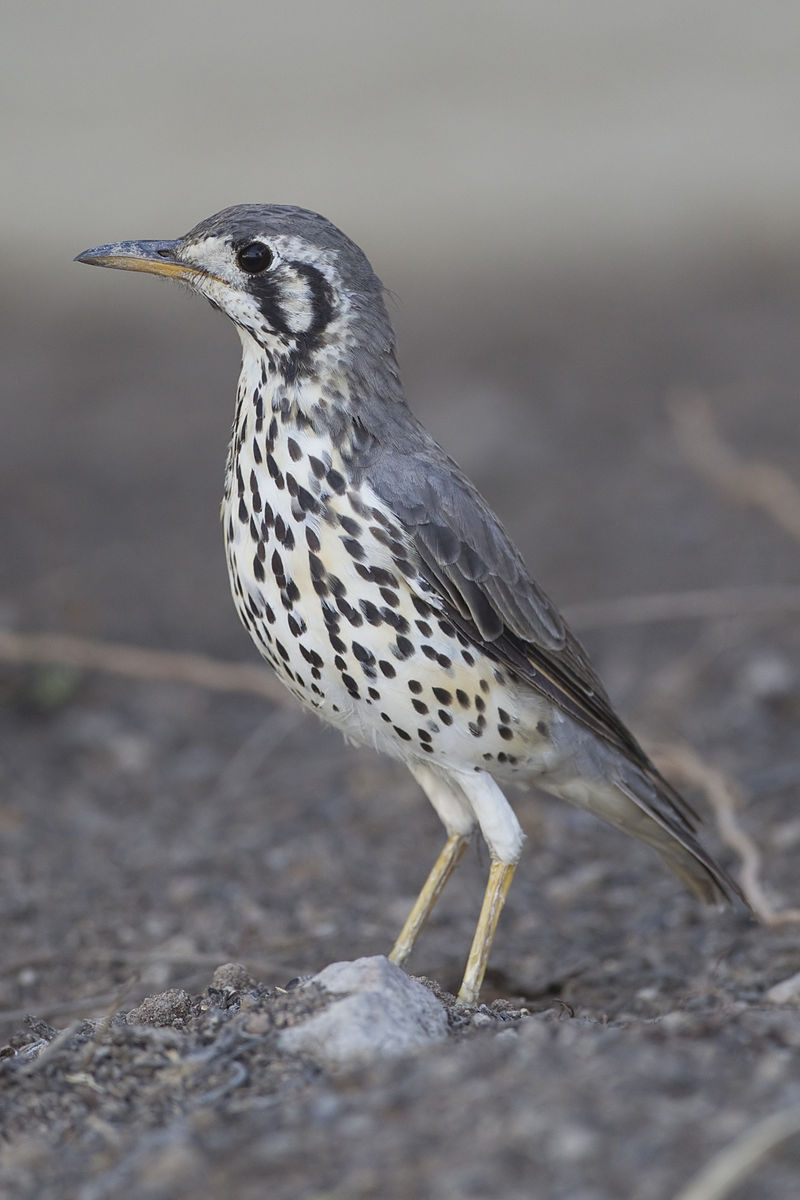
Thrushes are small to medium-sized birds belonging to the Turdidae family, and found all over the world. They live on or near the ground and feed on insects, other invertebrates and fruit.
Their feathers range from greyish browns to deep blues in colour with spotted wings that help them blend into their natural habitats such as forests, woodlands and shrubs.
Thrushes have distinctive songs which they sing during spring mating season; many species also perform complex flight displays for courtship rituals.
These birds may be solitary creatures but can often be seen foraging together in groups or pairs when searching for food sources like worms, snails or berries.
A healthy thrush population is an indication of a balanced environment since they require clean water sources as well as plenty of vegetation cover – making them important indicators of ecosystem health worldwide.Scientific classification:
| Kingdom | Animalia |
| Phylum | Chordata |
| Class | Aves |
| Order | Passeriformes |
| Suborder | Passeri |
| Family | Turdidae Rafinesque, 1815 |
Also Featured In: Common Birds in India, Most Common Romanian Birds
2. Northern Cardinal

The Northern Cardinal is a beautiful bird, easily identified by its bright red plumage. It can be found in the eastern United States from Maine to Minnesota and south through Mexico and Belize.
Along with its striking colouration, it has a distinctive crest on its head and sharp black facial markings around the eyes.
Despite their small size (measuring 7-9 inches) they are very vocal birds – males sing persistently throughout springtime to attract mates or proclaim their territory.
They typically feed on insects, seeds and fruits but also enjoy suet at backyard bird feeders.
The female is less brightly coloured than her mate but still stands out among other songbirds due to her warm brownish-red feathers.
Cardinals pair for life so you may often see them together in your garden or neighbourhood park.Scientific classification:
| Kingdom | Animalia |
| Phylum | Chordata |
| Class | Aves |
| Order | Passeriformes |
| Family | Cardinalidae |
| Genus | Cardinalis |
| Species | C. cardinalis |
Also Featured In: Most Common United States Birds, Birds for Your Home Garden
3. Northern Mockingbird
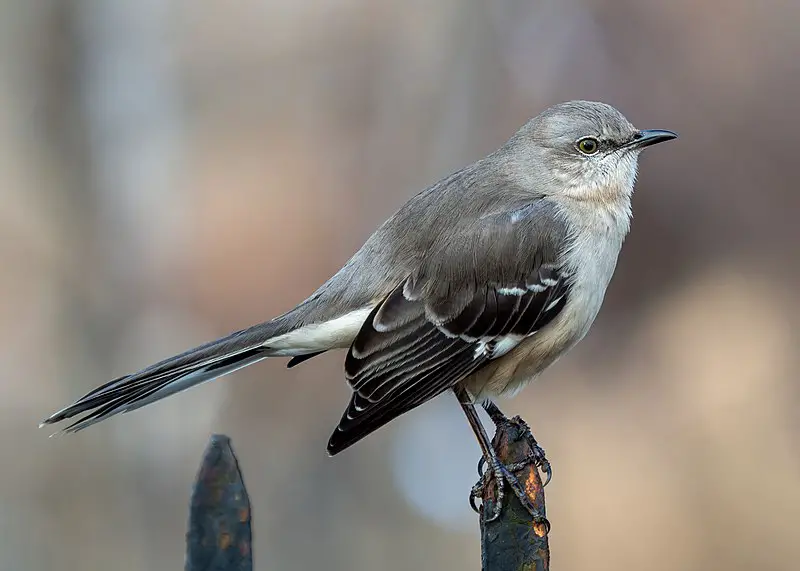
The northern mockingbird is a common fixture in North American skies. It has greyish-brown upperparts and a paler underside with white wing patches, and its distinctive long tail makes it easy to spot.
This adaptable bird can often be seen singing from the tops of trees or fences, though it rarely strays into Europe.
The species was first described by Carl Linnaeus in his 1758 Systema Naturae as Turdus polyglottos – aptly named for their remarkable ability to mimic other birds’ songs.
Northern mockingbirds typically live on insects, fruits, berries and seeds but they will also happily scavenge food scraps left out by humans.
With its beautiful song and striking plumage this beloved avian makes an important contribution to our environment.Scientific classification:
| Kingdom | Animalia |
| Phylum | Chordata |
| Class | Aves |
| Order | Passeriformes |
| Family | Mimidae |
| Genus | Mimus |
| Species | M. polyglottos |
Also Featured In: Birds Live Near San Diego, Birds Live in Arkansas
4. American Goldfinch
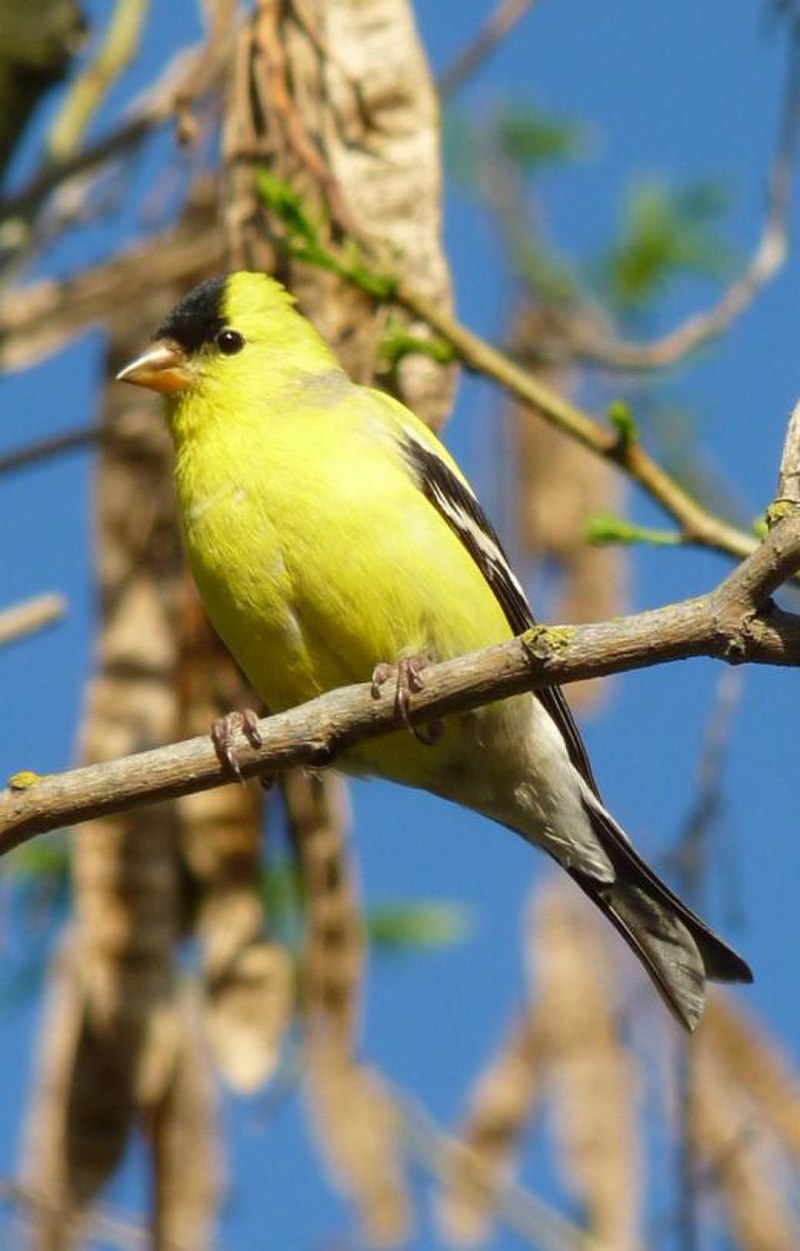
The American goldfinch is a small North American bird in the finch family. Males are vibrant yellow with black wings and tail, while females are duller in colouration.
It migrates from mid-Alberta to North Carolina during breeding season, south of Canada–United States border to Mexico for its wintering grounds.
The only finch which undergoes complete molt every year, it displays sexual dichromatism where males have brighter colours than their female counterparts.
They feed mainly on seeds but also eat insects such as aphids and caterpillars when raising youngs; they often occur near thistles or other plants that produce viable seed heads.
Their call consists of an array of chirps and trills making them quite conspicuous.Scientific classification:
| Kingdom | Animalia |
| Phylum | Chordata |
| Class | Aves |
| Order | Passeriformes |
| Family | Fringillidae |
| Subfamily | Carduelinae |
| Genus | Spinus |
| Species | S. tristis |
Also Featured In: Common Southern Californian Birds, Common Central Park Birds
5. Black-Capped Chickadee

The black-capped chickadee is a small and cheerful songbird found in deciduous and mixed forests across North America. It has an iconic black cap, white cheeks, gray back and wings with whitish bars on them.
The underparts are usually light colored or greyish brown. This species is well adapted to cold winters as it can reduce its body temperature by up to 8°C while roosting at night; this helps save energy during the colder months of the year.
It feeds mainly on insects but also eats seeds, fruits and suet from bird feeders when available.
Black-capped chickadees are popular birds among backyard visitors due to their sociable nature – they often establish lifelong partnerships with one another for breeding purposes.
Furthermore, they have been designated as state birds of Massachusetts and Maine in USA plus New Brunswick in Canada – a testament to how beloved these little avian friends truly are.Scientific classification:
| Kingdom | Animalia |
| Phylum | Chordata |
| Class | Aves |
| Order | Passeriformes |
| Family | Paridae |
| Genus | Poecile |
| Species | P. atricapillus |
Also Featured In: Common Birds in the Cities, Summer Birds that Live around Us
6. Eastern Bluebird
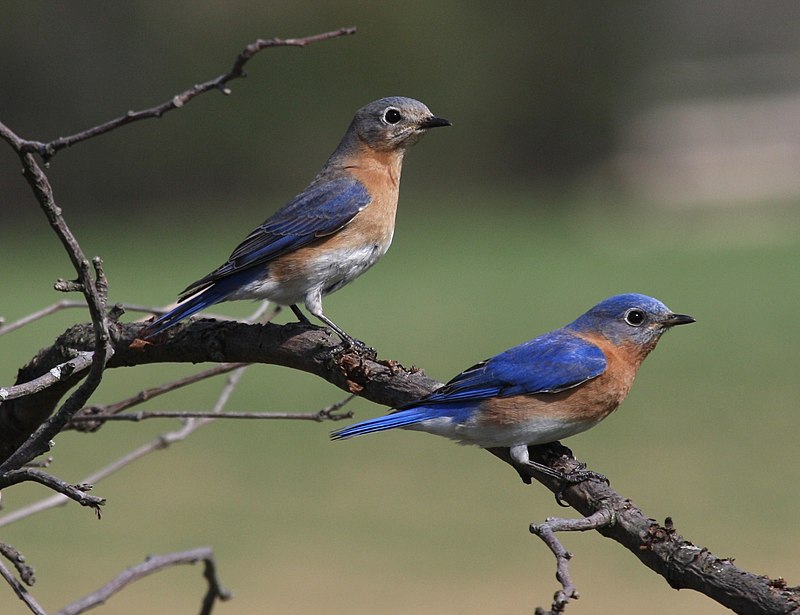
The Eastern bluebird is a small migratory thrush that can be found in open woodlands, farms and orchards across North America.
The male has bright-blue breeding plumage which makes it easily recognizable by birders.
It produces melodious songs such as jeew, chir-wi and chiti WEEW wewidoo.
This popular species was declared the state bird of Missouri back in 1927 due to its beauty and charm.
In addition to being beautiful, these birds are also beneficial for farmers because they eat insects like grasshoppers and beetles which damage crops.
They nest in cavities so providing nesting boxes helps them thrive even more.
With their vibrant colors, sweet melodies and helpful nature it’s easy to see why the Eastern Bluebird is beloved worldwide.Scientific classification:
| Kingdom | Animalia |
| Phylum | Chordata |
| Class | Aves |
| Order | Passeriformes |
| Family | Turdidae |
| Genus | Sialia |
| Species | S. sialis |
Also Featured In: House Birds You’ll Love to Pet, Birds that Migrate through Illinois in the Spring
7. Baltimore Oriole
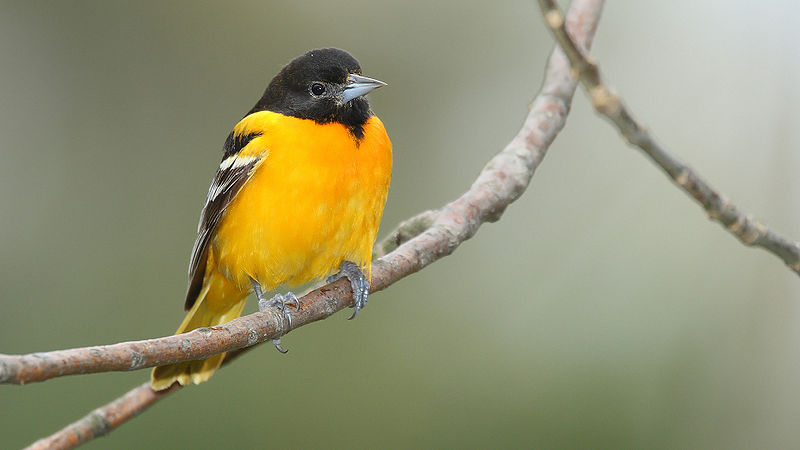
The Baltimore Oriole is a small, blackbird-like bird found in eastern North America. It’s named for the resemblance of its male colors to those on Lord Baltimore’s coat-of-arms from 17th century.
These birds migrate and breed during springtime and are quite common in their habitats.
Studies have shown that this species interbreeds with western Bullock’s orioles, leading both to be classified as a single species – Icterus galbula.
The males typically have orange feathers along the chest, back, wings and tail while females display tan or yellowish shades instead of bright orange ones like males do.
Both sexes share white wing bars and dark brown eyes which makes them easily distinguishable among other birds.
They can often be seen flitting around trees feeding off nectar buds or insects such as grasshoppers & caterpillars they catch while flying around.Scientific classification:
| Kingdom | Animalia |
| Phylum | Chordata |
| Class | Aves |
| Order | Passeriformes |
| Family | Icteridae |
| Genus | Icterus |
| Species | I. galbula |
Also Featured In: Birds that Calls in the Morning, Common Birds in Alberta
8. Northern Bobwhite
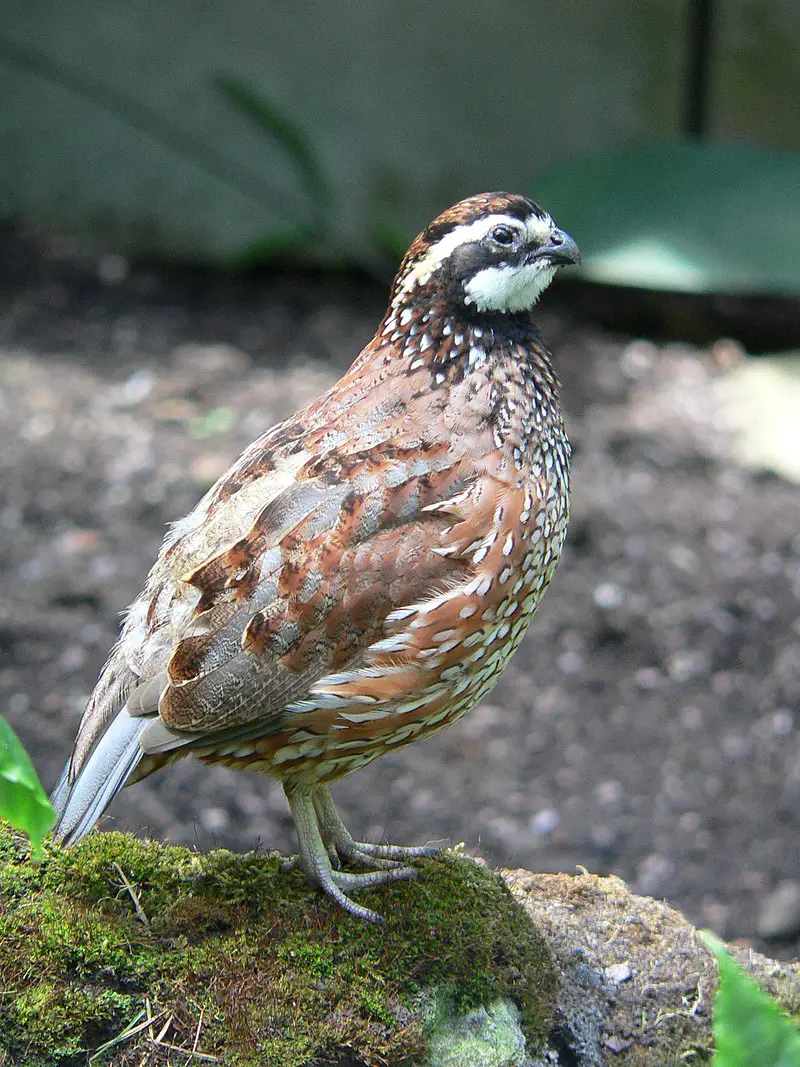
The Northern bobwhite is a ground-dwelling bird native to parts of the Americas, with introduced populations elsewhere in the world.
It belongs to the New World quail family and has a distinctive call that can be heard during mating season or when their territory is threatened.
They have mottled brown plumage which helps them blend into their natural habitats such as grasslands, wooded areas and open fields.
The male birds are slightly larger than females and they feed on small insects, seeds and plants.
These birds form monogamous breeding pairs that stay together throughout most of the year raising several broods each year until migrating south for winter months.
Though declining due to habitat loss, these resilient little birds can still be found living in many places across North America.Scientific classification:
| Kingdom | Animalia |
| Phylum | Chordata |
| Class | Aves |
| Order | Galliformes |
| Family | Odontophoridae |
| Genus | Colinus |
| Species | C. virginianus |
Also Featured In: Small Birds that Commonly Found in Ohio, Small Birds of Pennsylvania
9. New World Warblers

New World warblers are an incredibly diverse family of small birds found only in the Americas. They range in size from tiny hummingbirds to large thrushes, and come in a variety of vibrant colors.
All have thin bills made for eating insects which form their main diet. Most species live predominantly arboreal lives, meaning they spend most of their time among trees or bushes searching for food.
However some members such as ovenbirds and waterthrushes prefer more terrestrial habitats like forest floors where they can scavenge for bugs on the ground instead.
Warblers provide a great source of entertainment with their beautiful songs often filling up woodlands during mornings and evenings throughout springtime.Scientific classification:
| Kingdom | Animalia |
| Phylum | Chordata |
| Class | Aves |
| Order | Passeriformes |
| Superfamily | Emberizoidea |
| Family | Parulidae Wetmore et al., 1947 |
Also Featured In: Common Denmark Birds, Autumn Birds You Should Know
10. Downy Woodpecker
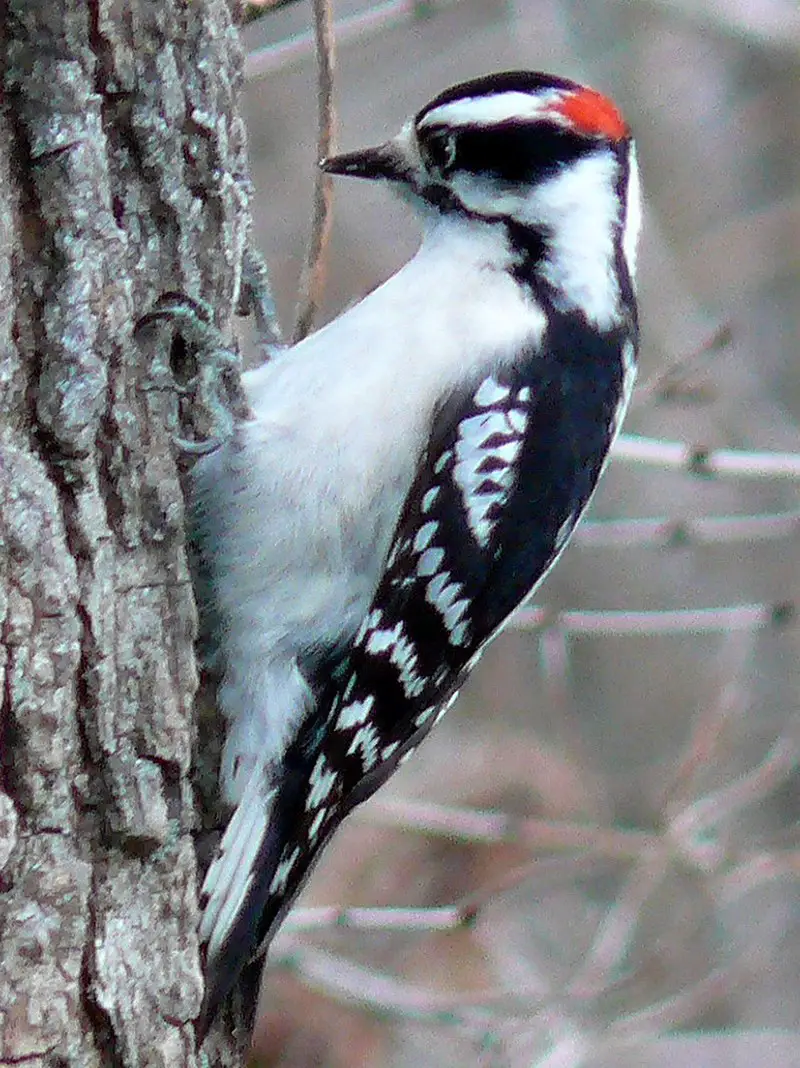
The downy woodpecker is a small species of woodpecker found in North America. Growing up to 7 inches long, it can be identified by its white belly and spotted wings.
It inhabits forests throughout the United States and Canada, with the exception of deserts in the southwest and northern tundra.
This bird nests in tree cavities and feeds mostly on insects but will supplement its diet with fruit or nuts when available.
The Downy Woodpecker has an unmistakable call that sounds like a loud ‘pik-er’, similar to other members of its family such as the Hairy Woodpecker.Scientific classification:
| Kingdom | Animalia |
| Phylum | Chordata |
| Class | Aves |
| Order | Piciformes |
| Family | Picidae |
| Genus | Dryobates |
| Species | D. pubescens |
Also Featured In: British Columbian Birds, Birds in Calgary You’ll Love to See
11. House Sparrow

The house sparrow is a small bird of the Passeridae family. It has an average length of 16 cm and weighs 24-39.5 gm.
Females have dull brown and grey plumage, whereas males are brighter, with black, white and brown markings on their wings and back feathers.
This species is one among 25 different kinds in its genus Passer .These birds are found all around the world mainly near human dwellings where they feed off food scraps from garbage bins or gardens etc..
They also make nests close to houses which makes them even more visible to people living nearby.
House sparrows can be seen hopping around yards looking for food during daytime hours but usually hide in colonies at night time.Scientific classification:
| Kingdom | Animalia |
| Phylum | Chordata |
| Class | Aves |
| Order | Passeriformes |
| Family | Passeridae |
| Genus | Passer |
| Species | P. domesticus |
Also Featured In: Asian Birds, European Birds
12. House Finch

The House Finch is a species of finch native to western North America and has been introduced in the eastern half of the continent as well as Hawaii.
It’s an average-sized finch with adults measuring 12.5 – 15 cm (5 – 6 inches) long and having wingspans between 20 – 25 cm (8 – 10 inches).
The upperparts are brown, while its underparts range from pale grayish white to yellow depending on subspecies.
Its face is streaked or spotted with reddish coloration; males typically have brighter plumage than females due to sexual dimorphism.
They’re mostly found near human habitations such as farms and gardens where they feed on grains, fruits, insects etc., making them very popular among birders who want something colorful for their backyard.Scientific classification:
| Kingdom | Animalia |
| Phylum | Chordata |
| Class | Aves |
| Order | Passeriformes |
| Family | Fringillidae |
| Subfamily | Carduelinae |
| Genus | Haemorhous |
| Species | H. mexicanus |
Also Featured In: Common Birds That Live in Las Vegas, Birds That Live around Seattle
13. Dark-Eyed Junco

The Dark-eyed Junco is a species of small, grayish sparrows that are found across much of temperate North America and in the Arctic during summer.
It was formally described by Carl Linnaeus in 1766, who named it after its distinctive dark eyes.
This bird has a very variable appearance due to the many different subspecies it contains, making its systematics difficult to unravel.
The plumage varies from white or light gray on their underparts with slate grey backs and wings; black heads with white outer tail feathers; brown head stripes; yellow bills; pink legs and feet; as well as various shades between all these colours.
They also have considerable sexual dimorphism where males tend to be more colourful than females but share similar characteristics such as short tails and rounded bodies – both sexes being around 16 cm long when fully grown.Scientific classification:
| Kingdom | Animalia |
| Phylum | Chordata |
| Class | Aves |
| Order | Passeriformes |
| Family | Passerellidae |
| Genus | Junco |
| Species | J. hyemalis |
Also Featured In: Birds that Live in San Francisco Bay Area, Lake Tahoe Birds
14. Common Starling

The Common Starling is a medium-sized passerine bird that belongs to the starling family. It has glossy black plumage with a metallic sheen, and in certain times of year it can be speckled with white.
The bill and legs are typically pink or black depending on the season, while its length measures about 8 inches long.
Its diet consists mainly of insects but also includes small fruits and seeds as well as some human food waste.
They live in large flocks which provides protection against predators, although they can become quite aggressive when defending their nesting sites during breeding seasons.
Overall, this species is highly adaptable and widely distributed across many parts of Europe making them one of the most successful birds in the region today.Scientific classification:
| Kingdom | Animalia |
| Phylum | Chordata |
| Class | Aves |
| Order | Passeriformes |
| Family | Sturnidae |
| Genus | Sturnus |
| Species | S. vulgaris |
Also Featured In: Flocks Birds around Us, Birds of Nova Scotia
15. Mourning Dove
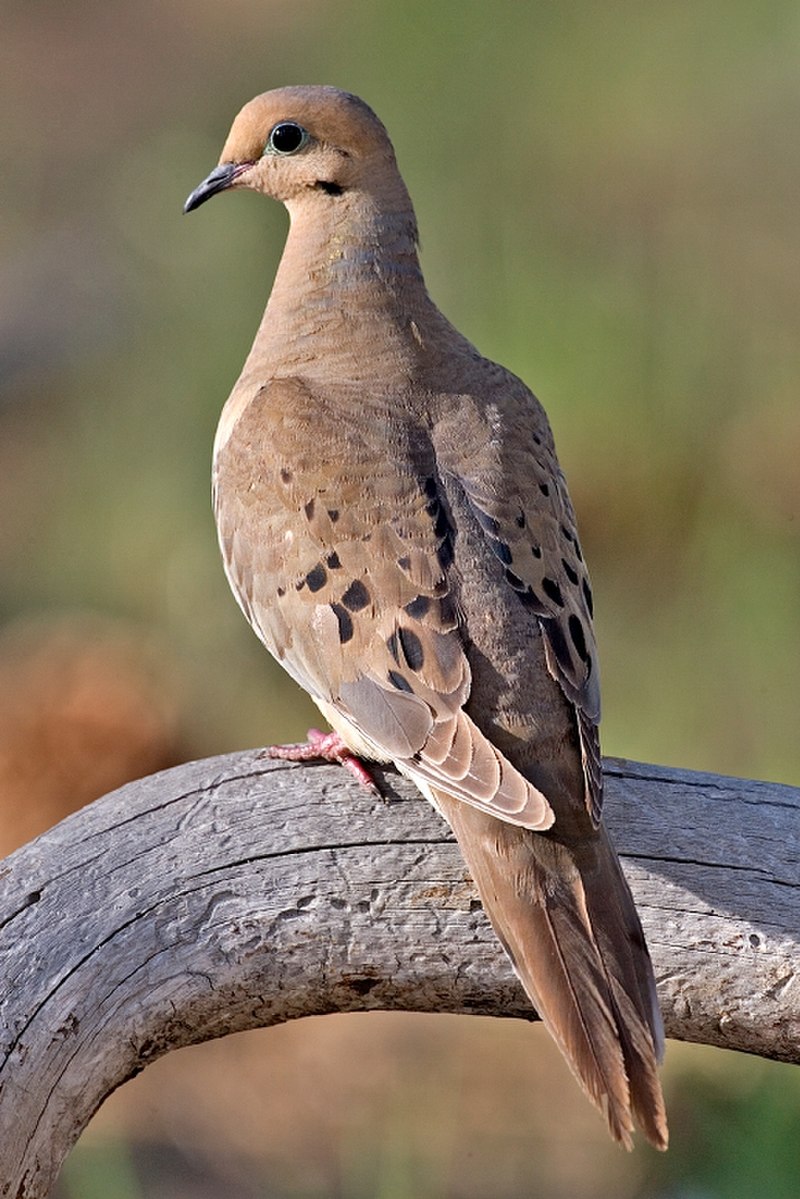
The Mourning Dove is a breathtakingly beautiful bird. It has stunning gray and brown feathers with white tipped wings, giving it an elegant appearance. Its long tail also adds to its graceful look in flight.
A symbol of peace and serenity, they are abundant across North America and can be found in gardens or open fields throughout the year.
As well as being popular game birds for hunters, they feed on grains such as wheat and millet providing important food sources for wildlife species including foxes, coyotes, skunks and raccoons.
These doves have a distinctive cooing sound that can often be heard echoing through woodlands during summer evenings making them one of nature’s greatest treasures.Scientific classification:
| Kingdom | Animalia |
| Phylum | Chordata |
| Class | Aves |
| Order | Columbiformes |
| Family | Columbidae |
| Genus | Zenaida |
| Species | Z. macroura |
Also Featured In: Most Common Nature Birds, Birds that Live in Mississippi
16. Tufted Titmouse

The Tufted Titmouse is a small, cheerful songbird found in North America. It’s part of the tit and chickadee family (Paridae).
It has distinctive white feathers around its eyes, grey-brown wings and upper body, with a pale tan underside.
Its most notable feature is the black crest on top of its head that gives it an inquisitive look. The male also sports a pinkish breast which can be seen.
When singing from high perches during the spring months. This bird loves to eat sunflower seeds or suet at backyard feeders as well as insects in summertime.
You may even see them poking into crevices and bark looking for food.
They are quite social birds too, being often spotted in mixed flocks alongside other species such as nuthatches and woodpeckers all year round.Scientific classification:
| Kingdom | Animalia |
| Phylum | Chordata |
| Class | Aves |
| Order | Passeriformes |
| Family | Paridae |
| Genus | Baeolophus |
| Species | B. bicolor |
Also Featured In: Common Birds of Houston, Small Birds that Live in Washington D.C.
17. White-Breasted Nuthatch

The White-breasted Nuthatch is a medium-sized bird belonging to the nuthatch family Sittidae. It measures around 15.5 cm in length and its colour varies throughout its range.
Males have a light blue-grey upperpart, with black crown and nape whereas females have a dark grey crown instead of black one.
The underparts are whitish, with reddish tinge on sides and flanks while the bill is short and stout with pale base near eyes which can be yellow or white depending upon geographic location..
This species feeds mainly on insects but will also eat seeds, nuts and berries when available.
They prefer open woodlands where they often climb trees searching for food along trunks as well as branches underneath bark crevices creating their nest there too.Scientific classification:
| Kingdom | Animalia |
| Phylum | Chordata |
| Class | Aves |
| Order | Passeriformes |
| Family | Sittidae |
| Genus | Sitta |
| Species | S. carolinensis |
Also Featured In: Birds Commonly Found in Northern California, Large Birds Live in Idaho
18. Red-Winged Blackbird

The red-winged blackbird is a beautiful bird found in most of North America and Central America.
Its distinct features include a glossy black body, with white shoulder patches and bright red wing coverts year round.
It prefers wetland habitats such as marshes, ponds, lakeshores and agricultural fields. During breeding season they inhabit grassy areas near water then move south for the winter months.
For food they mainly eat insects but also consume wild fruit or grains.
They are very social birds often seen in large flocks during migration times when their unmistakable “conk-la-ree” call can be heard echoing across the sky.Scientific classification:
| Kingdom | Animalia |
| Phylum | Chordata |
| Class | Aves |
| Order | Passeriformes |
| Family | Icteridae |
| Genus | Agelaius |
| Species | A. phoeniceus |
Also Featured In: Red birds You’ll See in Arizona, Red Birds You’ll See in Oklahoma
19. Brown-Headed Cowbird
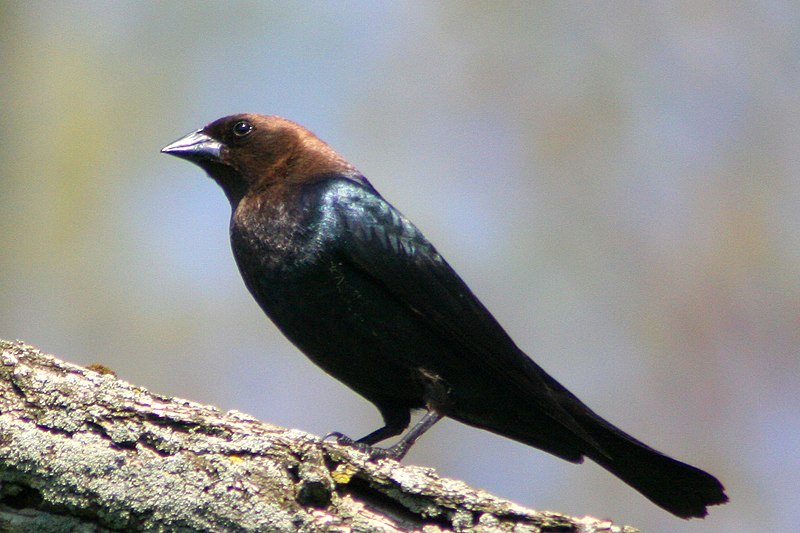
The Brown-headed Cowbird is a small, obligate brood parasitic icterid native to temperate and subtropical North America. It has a brown head with glossy black plumage on the body, wings and tail feathers.
During summer months it can be found in prairies, grasslands as well as open wooded areas but during winter they migrate southwards towards the United States of Mexico for warmer climate.
They are mainly insectivorous birds which feed on insects like caterpillars or beetles but also consume some grains too.
The female bird lays its eggs in nests of other species who then incubates them until hatching time thus leaving their own chicks uncared for by themselves.Scientific classification:
| Kingdom | Animalia |
| Phylum | Chordata |
| Class | Aves |
| Order | Passeriformes |
| Family | Icteridae |
| Genus | Molothrus |
| Species | M. ater |
Also Featured In: Most Popular Bird Species in North America, Birds You’ll Find in Vancouver Island
20. Gray Catbird
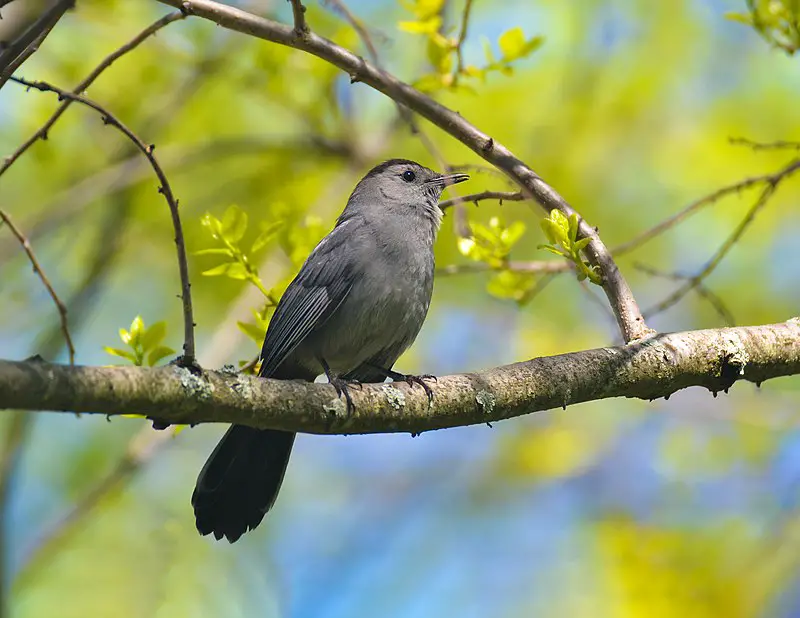
The Gray Catbird is a medium-sized bird native to North and Central America. It is the only species in its genus, Dumetella, which makes it unique among other perching birds of the Mimidae family.
Its plumage features shades of gray with some brownish tones on top and lighter grey below.
The underside of its tail has white feathers that contrast against their otherwise monochromatic coloration; this feature gives them their name as they often flick their tails when alarmed or excited like cats do.
They are omnivorous but mainly feed on insects such as caterpillars, grasshoppers, and beetles while also eating fruits like berries or cherries during summer months.
Despite being commonly seen alone or in pairs these birds will flock together at times for protection from predators like hawks who are drawn to their dark colouration against green foliage making them harder to spot.Scientific classification:
| Kingdom | Animalia |
| Phylum | Chordata |
| Class | Aves |
| Order | Passeriformes |
| Family | Mimidae |
| Genus | Dumetella C.T. Wood, 1837 |
| Species | D. carolinensis |
Also Featured In: Gray Birds that You’ll Find in Minnesota, Birds that Live in Manitoba
21. Common Grackle

The Common Grackle is a large icterid bird commonly found in North America. It has an iridescent head and pale yellow eyes, which are framed by its long dark bill and long tail.
Males typically have more vivid colors on their heads than females do. These birds can be seen across much of the continent, in fields, forests, wetlands – even urban areas.
They form huge flocks to search for food such as grains or insects that they catch with their bills.
The grackles may also scavenge from human sources like garbage dumps or picnic tables if available. With its colorful plumage and distinct call it’s easy to spot this species amongst other birds.Scientific classification:
| Kingdom | Animalia |
| Phylum | Chordata |
| Class | Aves |
| Order | Passeriformes |
| Family | Icteridae |
| Genus | Quiscalus |
| Species | Q. quiscula |
Also Featured In: Central Texas Birds, Birds that Live around Central Florida
22. Cuckoos
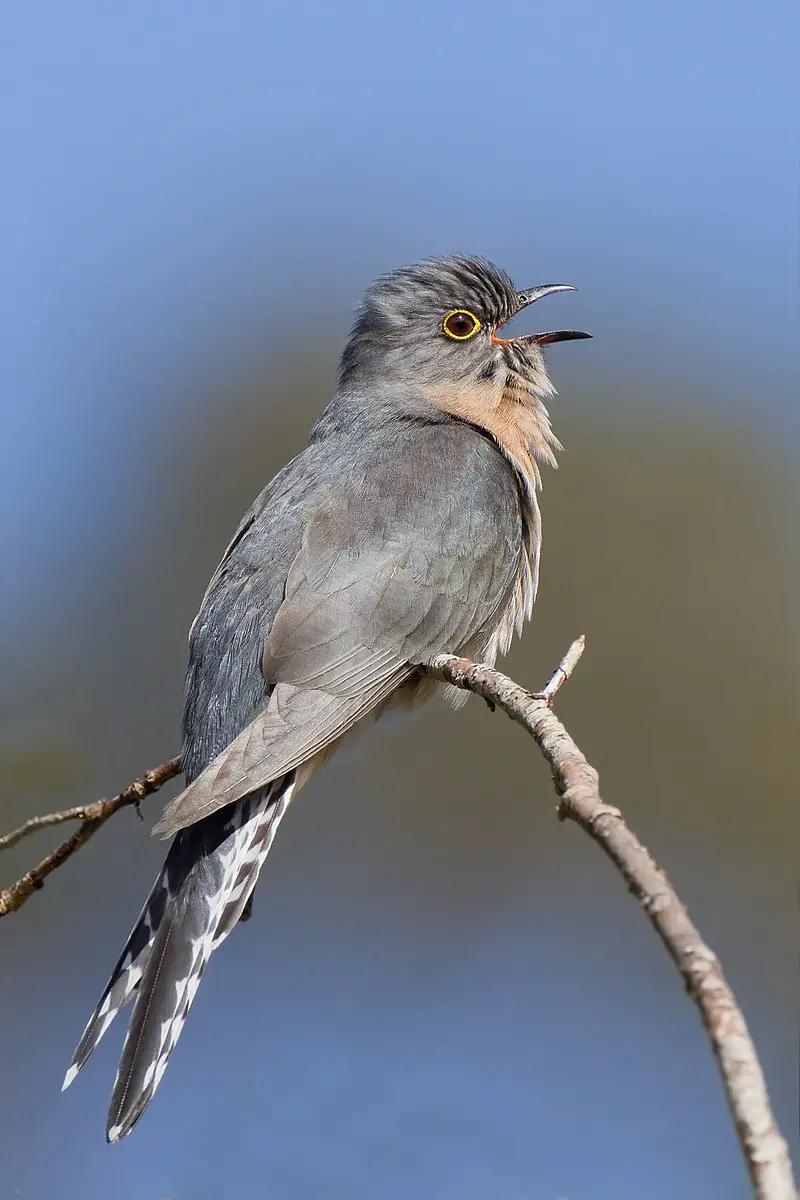
Cuckoos are fascinating birds belonging to the Cuculidae family, which is the only taxon in the order of Cuculiformes.
There are many different species within this family such as common or European cuckoo, roadrunners, koels, malkohas, couas and anis.
Some of these species may even be identified as separate families – Centropodidae and Crotophagidae respectively.
These birds have been known for their unique features such as loud calls heard consistently during certain times of day and night.
They also exhibit behavior like brood parasitism where they lay eggs in other nests so that their chicks can get more food from host parents than its own.
All these traits make them one-of-a-kind creatures worth admiring.Scientific classification:
| Kingdom | Animalia |
| Phylum | Chordata |
| Class | Aves |
| Clade | Otidimorphae |
| Order | Cuculiformes Wagler, 1830 |
| Family | Cuculidae Leach, 1820 |
Also Featured In: Most Common Types of Bangladeshi Birds, Birds of Sweden
23. Loggerhead Shrike
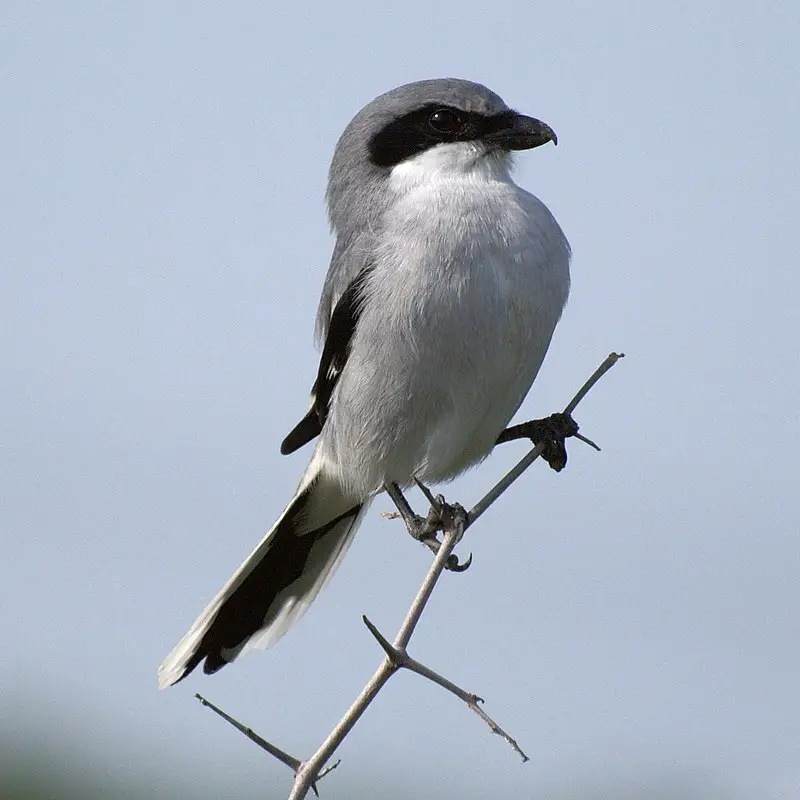
The Loggerhead Shrike is a carnivorous bird found only in North America. It belongs to the family Laniidae and is known as the “butcherbird” because of its habit of catching prey, such as amphibians, insects, lizards and small mammals.
The shrike has a black mask around its eyes and grey wings with white patches on them.
Its back is black with white spots that resemble stars or snowflakes; some individuals may have brown feathers instead of black ones.
This species feeds mainly by perching from elevated locations like bushes or trees where it can spot potential meals below it before diving down for capture.
Interestingly enough, these birds are also known to store their food by impaling it onto thorns which they use later when hungry.
With less than 2 million estimated population left in wild today this species needs our help so we should do whatever we can to protect them better.Scientific classification:
| Kingdom | Animalia |
| Phylum | Chordata |
| Class | Aves |
| Order | Passeriformes |
| Family | Laniidae |
| Genus | Lanius |
| Species | L. ludovicianus |
Also Featured In: Top Birds Found in Mexico, Common Birds of Prairie
24. American White Ibis
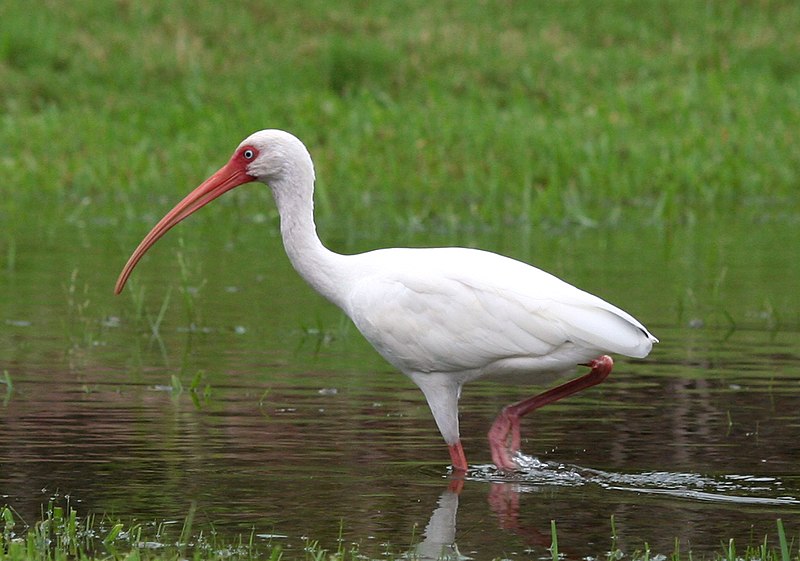
The American white ibis is a medium-sized bird with an overall white plumage and long legs. It has a bright red-orange downward curved bill, and black wing tips that are usually only visible in flight.
This species of ibis can be found from Virginia south through most of the coastal New World tropics.
They have been known to inhabit marshes, swamps, ponds, lakeshores as well as mangrove forests near water sources where they feed on crustaceans such as crabs and shrimp among other aquatic animals like insects or snails.
The American white ibis plays an important role in its ecosystem by helping to control insect populations which helps maintain balance within these environments.Scientific classification:
| Kingdom | Animalia |
| Phylum | Chordata |
| Class | Aves |
| Order | Pelecaniformes |
| Family | Threskiornithidae |
| Genus | Eudocimus |
| Species | E. albus |
Also Featured In: Birds You’ll Find in South Texas , Everglades Birds
25. Loons
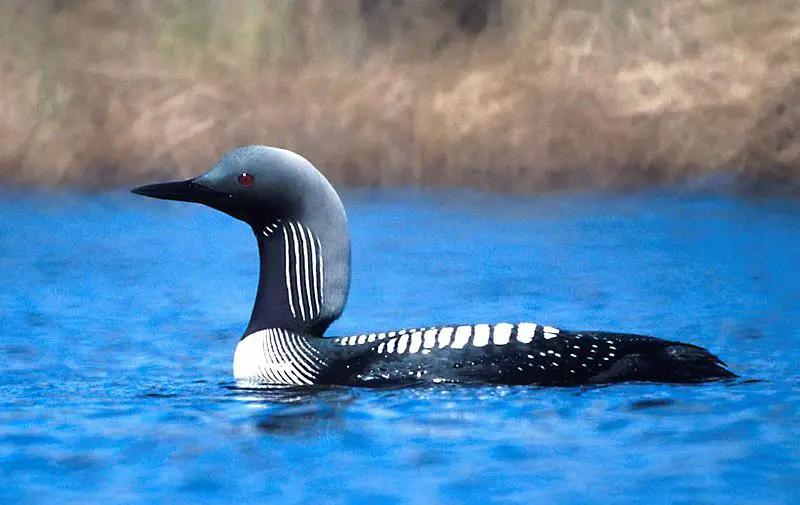
Loons are an aquatic bird found in both North America and northern Eurasia. They can be identified by their size, which is similar to that of large ducks or small geese.
When swimming, loons resemble these birds in shape as well as movement.
Unlike other waterfowl however, they have pointed bills with serrated edges and feet set far back on their bodies; this makes them excellent swimmers but hinders the ability to walk on land properly.
Loons feed mainly on fish but also eat insects and crustaceans when available.
In addition to being a common sight around lakes during warmer months, many species migrate south for winter where they live near coastal waters until returning again in springtime.Scientific classification:
| Kingdom | Animalia |
| Phylum | Chordata |
| Class | Aves |
| Order | Gaviiformes |
| Family | Gaviidae Coues, 1903[1] |
| Genus | Gavia Forster, 1788 |
Also Featured In: Common Birds in Canada, Water Birds Live around Us
26. Red-Breasted Nuthatch

The Red-breasted Nuthatch is a beautiful and vocal songbird that can be found in coniferous forests across Canada, Alaska, the northeastern United States and western US.
This small bird has blue-grey upperparts with cinnamon underparts, a white throat and face with black eye stripe, straight grey bill and black crown.
Its call sounds like a tin trumpet; it’s high-pitched yet nasal.
During mating season they form monogamous pairs to build their nest near tree trunks or branches at low heights off the ground where they lay 2 – 8 eggs at once.
They are very active little birds who love clinging to trees while searching for insect larvae or seeds within the bark of trees which helps control pest populations.Scientific classification:
| Kingdom | Animalia |
| Phylum | Chordata |
| Class | Aves |
| Order | Passeriformes |
| Family | Sittidae |
| Genus | Sitta |
| Species | S. canadensis |
Also Featured In: Acadia National Park Birds, Red Minnesota Birds You Need to Know
27. Song Sparrow

The Song Sparrow (Melospiza melodia) is a small, yet abundant bird found in North America.
They have brown upperparts with dark streaks and are white underneath, complete with a distinct dark brown spot on the breast.
Their cap is also brown and long roughed feathers can be seen sprouting from their neck area.
This sparrow species is highly variable and adaptable to many different environments including dry brush land, wetlands or open fields.
It has been noted that adult song sparrows will sing even during winter months when other birds remain quiet.
These energetic little animals make for great backyard companions as they flit about singing their lovely melodies.Scientific classification:
| Kingdom | Animalia |
| Phylum | Chordata |
| Class | Aves |
| Order | Passeriformes |
| Family | Passerellidae |
| Genus | Melospiza |
| Species | M. melodia |
Also Featured In: Brown Birds that Live in West Virginia, Brown Birds that are Found in Mississippi
28. Black Vulture
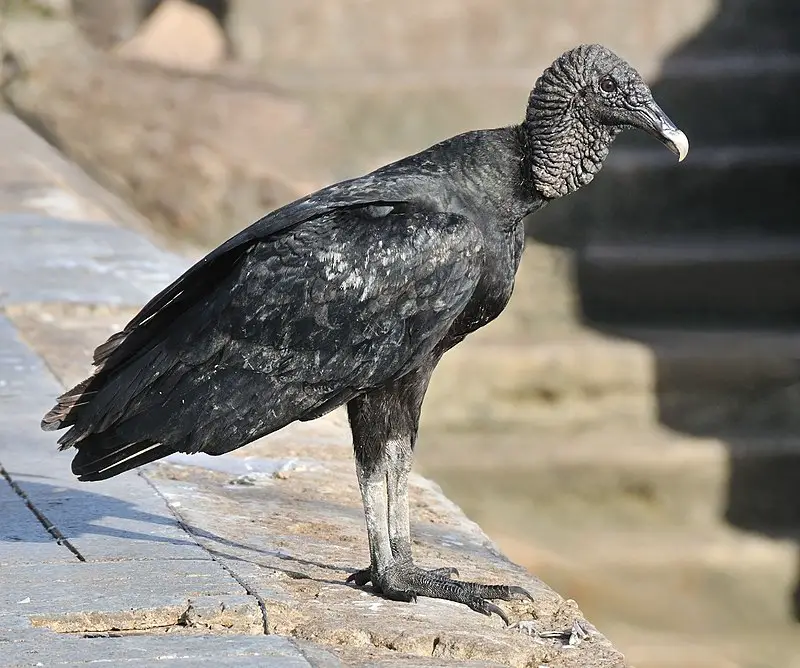
The black vulture is a common and widespread species of New World Vultures, found in the northeastern United States all the way to Peru, Central Chile and Uruguay.
It’s distinctive appearance has earned it many nicknames such as zopilote, urubu or gallinazo.
This medium-sized bird has mainly black plumage with some white markings on its wings and head; also featuring a long bill for scavenging carrion from carcasses.
Despite being able to fly up high due to its broad wingspan, it prefers keeping close to ground level when searching for food items like dead fish or small mammals that are available near human settlements.
As an apex predator they play an important role in nature by helping keep their environment clean while providing other animals with sustenance through their leftovers.Scientific classification:
| Kingdom | Animalia |
| Phylum | Chordata |
| Class | Aves |
| Order | Accipitriformes |
| Family | Cathartidae |
| Genus | Coragyps |
| Species | C. atratus |
Also Featured In: Most Common Birds Found in Chile, Birds You’ll Find in Zoo
29. Carolina Chickadee
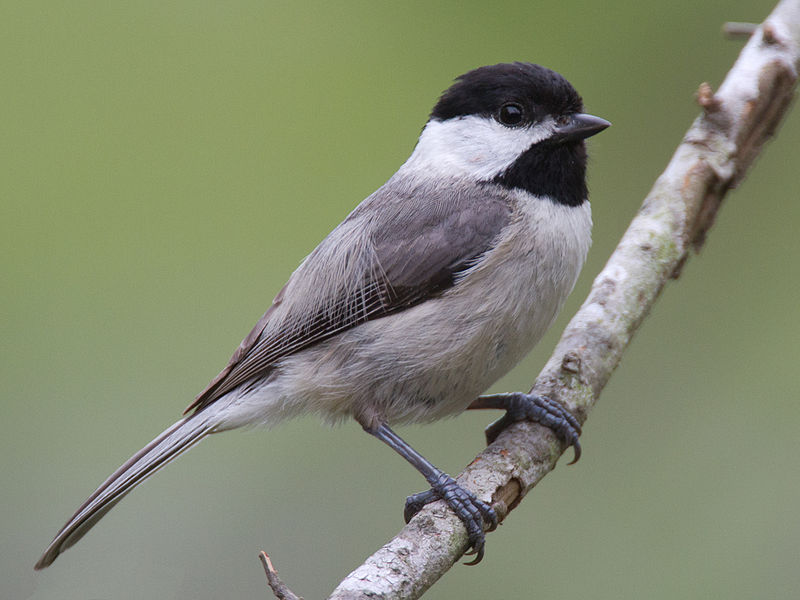
The Carolina Chickadee is a small passerine bird found in the tit family Paridae. It stands out for its distinct black and white, grey-brown feathers with an offwhite underside.
This species can be spotted by its call: “chick-a-dee”. The American Ornithologists’ Union has classified them into their own genus called Poecile as they differ from other tits due to both genetic data and morphology.
These birds are found all over North America, living in wooded areas near open fields or water sources.
They feed on insects such as caterpillars but also have been known to eat suet at backyard feeders during winter months when food is scarce.Scientific classification:
| Kingdom | Animalia |
| Phylum | Chordata |
| Class | Aves |
| Order | Passeriformes |
| Family | Paridae |
| Genus | Poecile |
| Species | P. carolinensis |
Also Featured In: Georgia Birds, Small Birds of Texas
30. Ruby-Throated Hummingbird

The ruby-throated hummingbird (Archilochus colubris) is a species of hummingbird that has an impressive migration pattern, spending the winter in Central America, Mexico and Florida before flying to Canada and other parts of Eastern North America for breeding season.
It’s by far the most common type seen east of the Mississippi River in North America.
Formally described by Swedish naturalist Carl Linnaeus in 1758, this tiny bird has bright metallic green upperparts with white underparts, a small black bill and a red throat patch which gives it its name; they measure around 3 inches long on average.
They feed primarily on nectar from flowers but also eat insects such as flies or mosquitoes for extra protein during their migrations or when raising young chicks.Scientific classification:
| Kingdom | Animalia |
| Phylum | Chordata |
| Class | Aves |
| Order | Apodiformes |
| Family | Trochilidae |
| Genus | Archilochus |
| Species | A. colubris |
Also Featured In: Red Birds You’ll Commonly Found in Texas, Red Birds that Live in Tennessee
31. Ruby-Crowned Kinglet
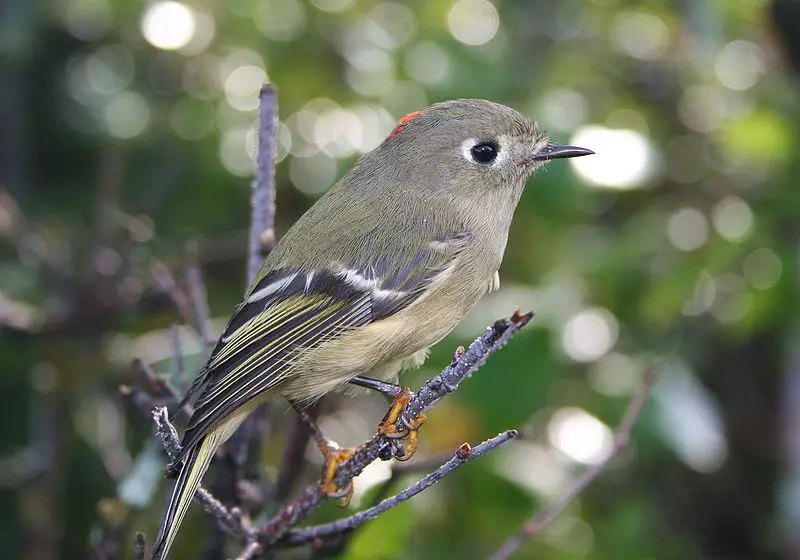
The Ruby-crowned Kinglet is a small passerine bird native to North America. It has olive green plumage, white wing bars and an eye-ring as well as a distinctive red crown patch on the males.
Juveniles look similar to adults with no distinguishing features other than size.
They are usually found in coniferous forests or woodlands where they spend much of their time searching for insects among foliage and branches while constantly flitting from place to place.
These birds have incredible energy levels that allow them to travel long distances during migration season without getting exhausted too quickly, making them one of nature’s most resilient species.Scientific classification:
| Kingdom | Animalia |
| Phylum | Chordata |
| Class | Aves |
| Order | Passeriformes |
| Family | Regulidae |
| Genus | Corthylio Cabanis, 1853 |
| Species | C. calendula |
Also Featured In: Birds You’ll Find in the Rio Grande Valley, Native Birds in Lower Rio Grande Valley
32. Eastern Phoebe
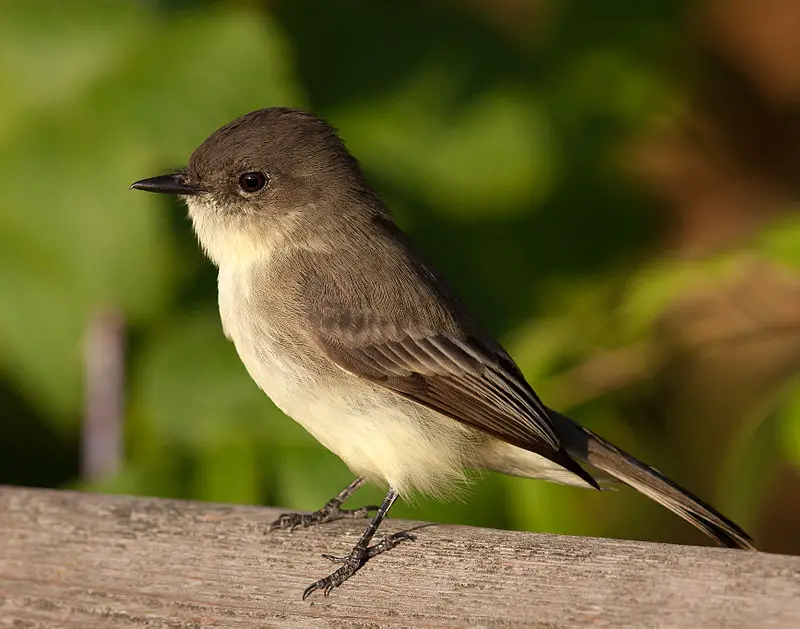
The Eastern Phoebe is a small passerine bird belonging to the genus Sayornis. It gets its name from Charles Lucien Bonaparte’s Muscicapa saya, and Ancient Greek ornis meaning “bird”.
The species’ alternative name ‘Phoebe’ comes from the Roman moon-goddess Diana, but also has been said to imitate their call.
Measuring up to 16 cm in length with a wingspan of 25–30 cm, they have grayish brown upperparts and pale underparts.
They are found near streams, woodlands and open fields where they hunt for insects such as flies, bees wasps etc., often catching them midair or by sallying out from perchs like branches or fences.
These birds make shallow cup nests made of grasses lined with mud which are built on cliffs ledges walls buildings bridges trees etc..
All in all this beautiful little bird is an interesting addition wherever you find it.Scientific classification:
| Kingdom | Animalia |
| Phylum | Chordata |
| Class | Aves |
| Order | Passeriformes |
| Family | Tyrannidae |
| Genus | Sayornis |
| Species | S. phoebe |
Also Featured In: Birds that Make Mud Nests, Brown Tennessee Birds
33. House Wren
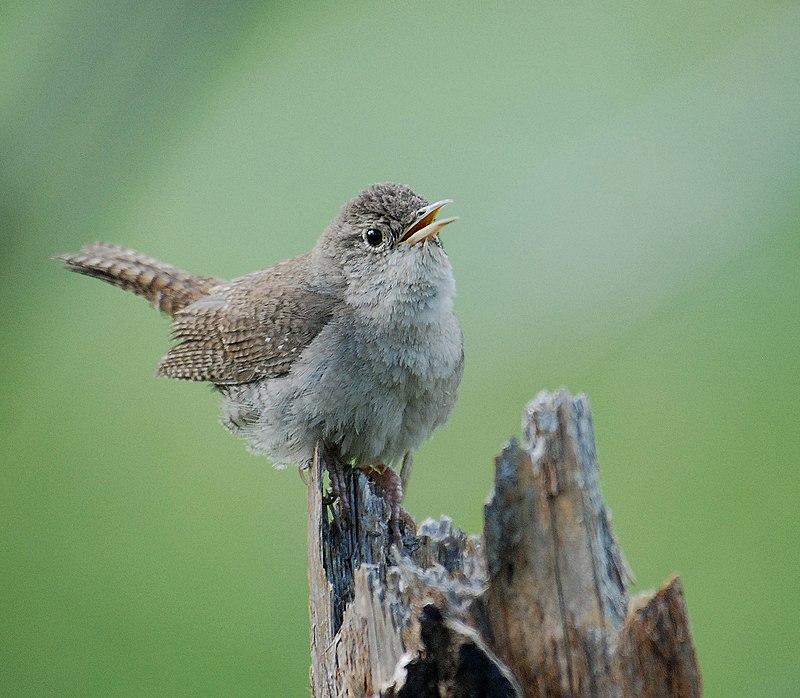
The House Wren is a small bird of the wren family found from Canada to South America. It’s quite common in suburban areas and is one of the most widely distributed native birds in North and South America.
Its taxonomy can be complicated, with some subspecies groups considered separate species.
The House Wren has a brown back, grey head, white eyebrow stripes, light chestnut belly and buffy flanks.
They often inhabit old or abandoned buildings as well as shrublands near fields or open woods for nesting sites.
During breeding season they are highly territorial so make sure you create an inviting environment if you wish to invite them into your yard.Scientific classification:
| Kingdom | Animalia |
| Phylum | Chordata |
| Class | Aves |
| Order | Passeriformes |
| Family | Troglodytidae |
| Genus | Troglodytes |
| Species | T. aedon |
Also Featured In: Suriname birds, Small Birds Live in Vermont
34. White-Eyed Vireo
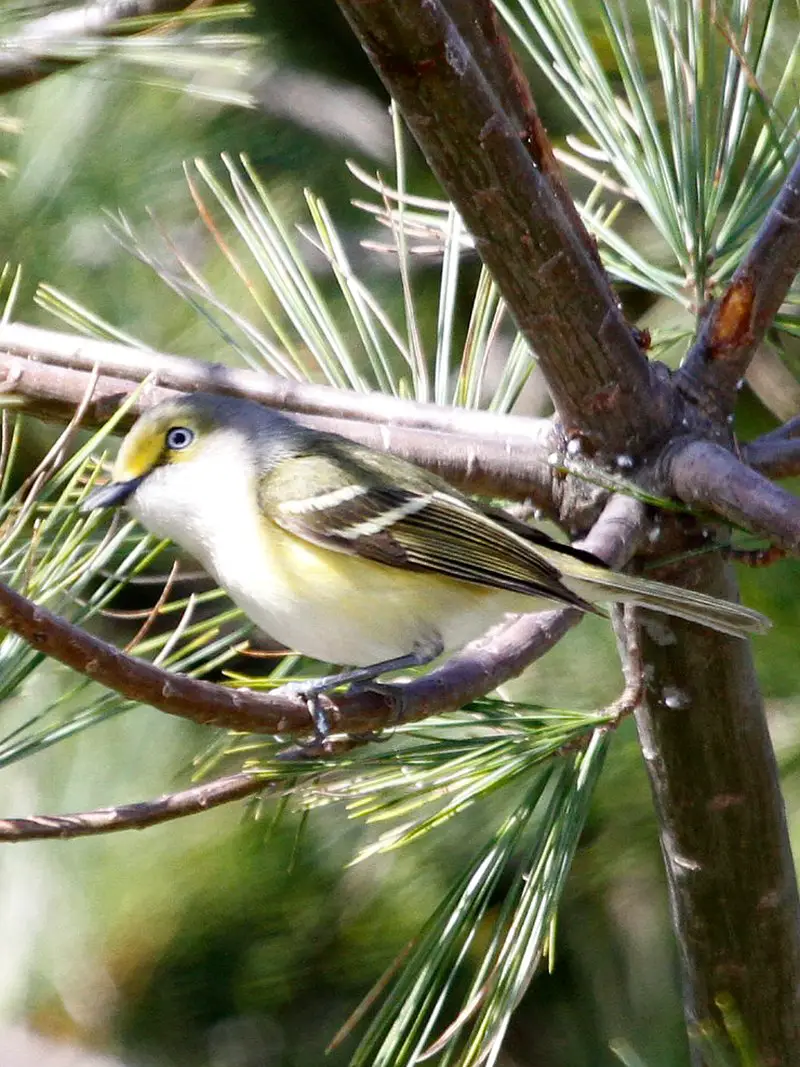
The White-eyed vireo is a small songbird in the family Vireonidae, native to parts of eastern United States from New England to northern Missouri, Texas and Florida.
It also occurs in Mexico, Central America, Cuba and Caribbean islands such as Bahamas.
These birds are migratory on their North American range but become resident further south towards Gulf Coast.
They inhabit wooded areas with thick shrubbery or foliage which offer plenty of insects for them to feed upon.
Their call consists of sharp ‘chick’ notes while they sing a sweet melodious warble during breeding season making them popular among birdwatchers all over the world.Scientific classification:
| Kingdom | Animalia |
| Phylum | Chordata |
| Class | Aves |
| Order | Passeriformes |
| Family | Vireonidae |
| Genus | Vireo |
| Species | V. griseus |
Also Featured In: Bermuda birds, Yellow Birds You’ll Find in North Carolina
35. Boreal Chickadee
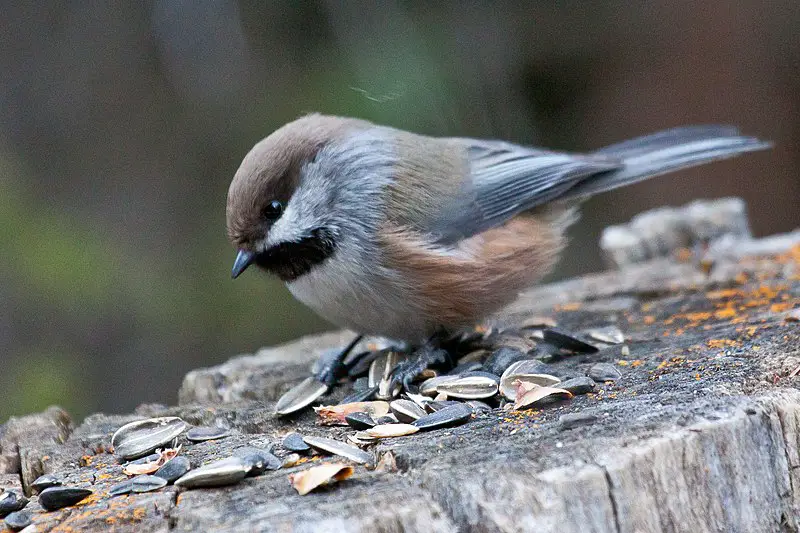
The Boreal Chickadee is a small, sparrow-like bird that inhabits the boreal forests of Canada and northern United States.
It has a distinct trill call that it uses to communicate with other birds in its area.
This species can be identified by its gray cap and bib, white cheeks, whitish underparts, black wings and tail feathers.
It also has yellow feet which helps distinguish it from similar looking birds like the Black-capped chickadee or the Carolina chickadee.
This species tends to remain within their range year round as they are nonmigratory birds due to their food storage habits during winter months when food sources become scarce.
They store food throughout trees using special techniques such as caching seeds into bark crevices or burying them underground for later retrieval when needed most.Scientific classification:
| Kingdom | Animalia |
| Phylum | Chordata |
| Class | Aves |
| Order | Passeriformes |
| Family | Paridae |
| Genus | Poecile |
| Species | P. hudsonicus |
Also Featured In: Chickadees Birds, Common Birds in Saskatchewan
36. Blue-Gray Gnatcatcher
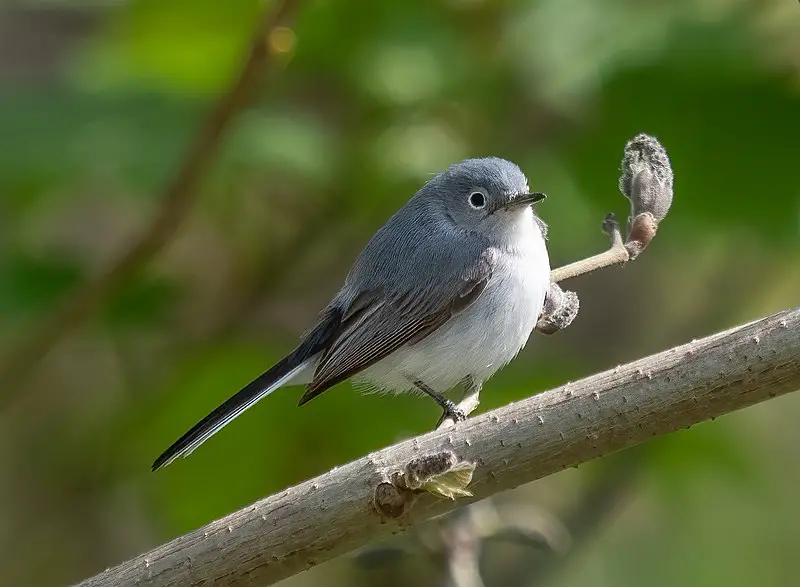
The Blue-gray Gnatcatcher is a beautiful small songbird native to North America. It has a length of 10–13 cm (3.9–5.1 in), wingspan of 6.3 in (16 cm) and weighs only 5–7 g (0.18–0.25 oz).
Males have blue-gray upperparts with white underparts, slender dark bill, and long black tail edged in white; females are less vibrant but still eye catching.
Juveniles are brownish gray overall but may show some hints of the adult colouration around their tails or shoulders as they mature into adulthood.
Their diet consists mainly of insects which they catch while flitting through air like tiny darts.
This stunning species can be found anywhere from woodlands to urban parks so keep your eyes peeled for these delightful creatures on your next outdoor adventure.Scientific classification:
| Kingdom | Animalia |
| Phylum | Chordata |
| Class | Aves |
| Order | Passeriformes |
| Family | Polioptilidae |
| Genus | Polioptila |
| Species | P. caerulea |
Also Featured In: Birds That Live in Colorado, Blue Birds You’ll Found around Us
37. Brown Creeper
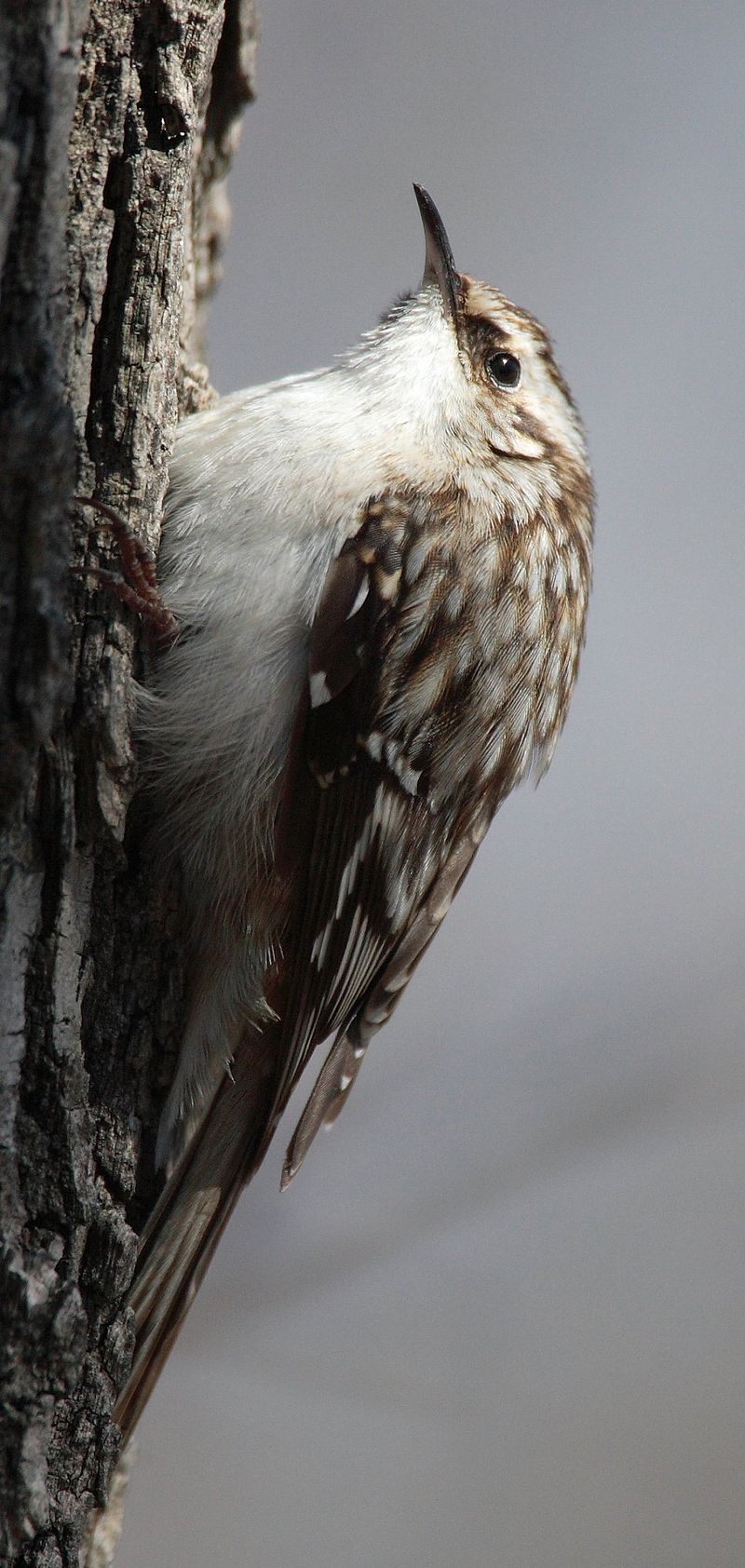
The Brown Creeper is a small songbird belonging to the Certhiidae family and is native to North America. It has brown upperparts with light spotting that resembles tree bark, as well as white underparts.
Its bill is long and thin with a slight downward curve while its tail is also long yet stiff; this helps it creep up trees.
This bird feeds mainly on insects which can be found in crevices of barks or dead plants, thanks to its curved bill which allows it access these hard-to-reach places.
When searching for food they move diagonally upwards around trunks so their camouflage blends in perfectly with the background making them difficult to spot.Scientific classification:
| Kingdom | Animalia |
| Phylum | Chordata |
| Class | Aves |
| Order | Passeriformes |
| Family | Certhiidae |
| Genus | Certhia |
| Species | C. americana |
Also Featured In: New Hampshire Birds You Should Know, Birds in Iowa Spring
38. Common Redpoll
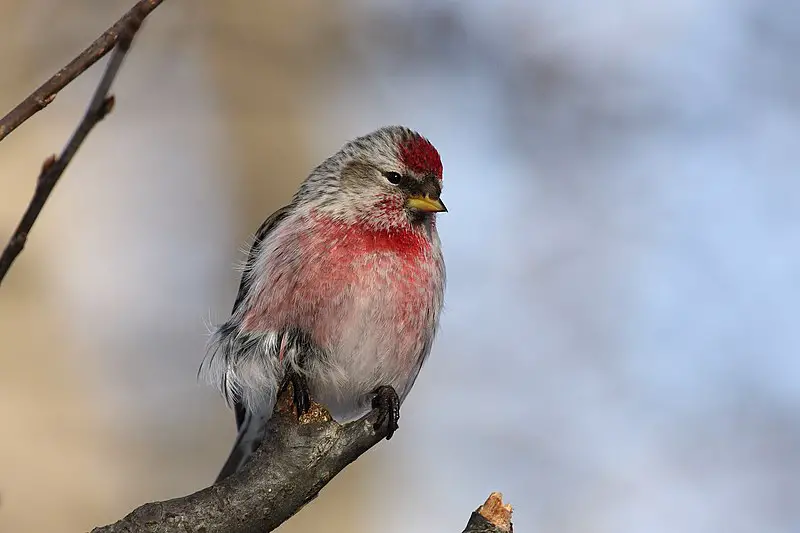
The Common Redpoll is a species of bird belonging to the finch family. It has an orange-red crown, white breast and grey back with two black stripes running down either side.
Its wings are barred in browns and its tail feathers have a grayish tinge at their tips. The redpoll breeds mainly south from Arctic regions in habitats that contain shrubs or thickets.
First classified by Linnaeus in 1758 under the binomial name Fringilla flammea, it’s genus Acanthis originates from Ancient Greek akantha meaning “thorn” or “prickle”.
This small yet colourful bird feeds mainly on seeds such as thistles during summer months but switches over to birch catkins when winter arrives – making them a common sight throughout much of North America and Eurasia.Scientific classification:
| Kingdom | Animalia |
| Phylum | Chordata |
| Class | Aves |
| Order | Passeriformes |
| Family | Fringillidae |
| Subfamily | Carduelinae |
| Genus | Acanthis |
| Species | A. flammea |
Also Featured In: Finches Species, Most Common Winter Birds
39. Yellow-Bellied Flycatcher
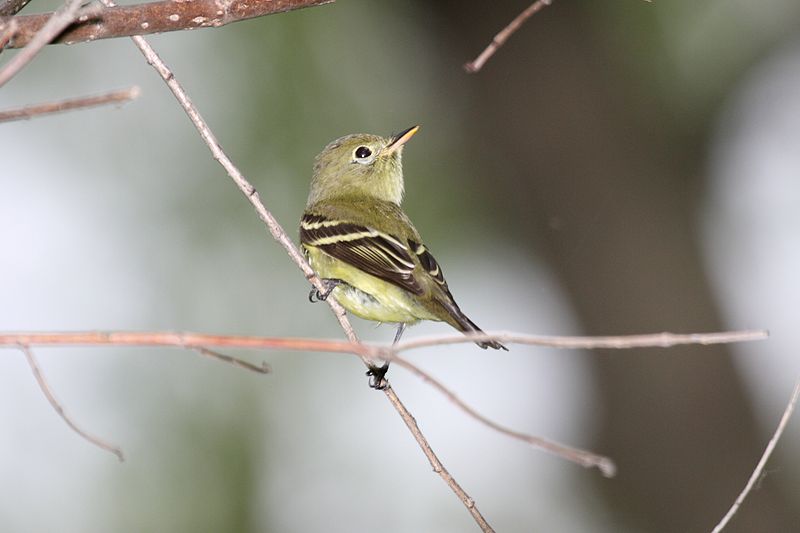
The Yellow-bellied Flycatcher is a small bird of the tyrant flycatcher family. It has greenish upperparts and yellowish underparts, with a dusky wash on its chest.
Its distinctive feature is the white or yellow eye ring that lacks any teardrop projection – setting it apart from other similar species in its family.
This insectivorous bird can be found in open habitats such as forest edges and woodland clearings across much of North America during summer months, when they migrate south to warmer areas for wintertime nesting.
They feed mainly on insects caught by sallying out after them from an exposed perch, but also take fruit occasionally at times of year when there are fewer flying insect prey available to eat.Scientific classification:
| Kingdom | Animalia |
| Phylum | Chordata |
| Class | Aves |
| Order | Passeriformes |
| Family | Tyrannidae |
| Genus | Empidonax |
| Species | E. flaviventris |
Also Featured In: Flycatchers Species, Birds that Live in Newfoundland and Labrador
40. Black-And-White Warbler
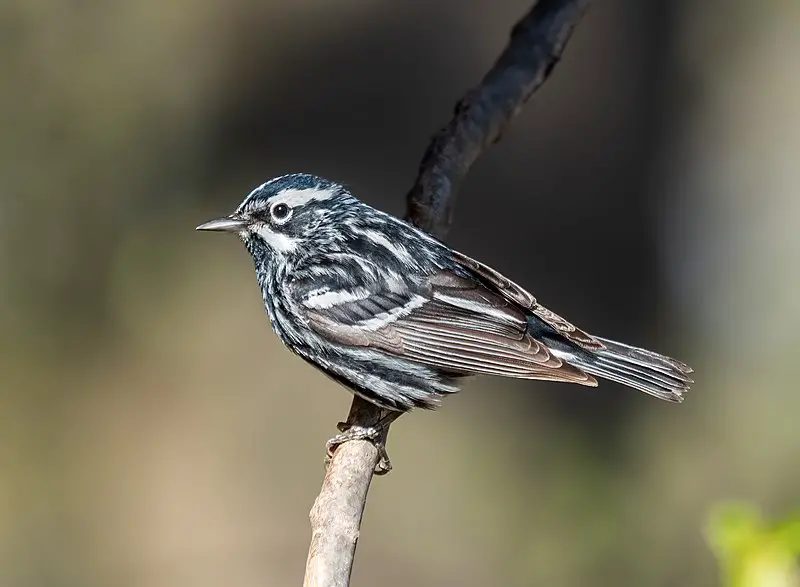
The Black-and-white Warbler is a unique species of bird native to North America. It has striking black and white plumage and breeds in the northern part of the continent, wintering in Central America, Florida, West Indies and Peru.
This warbler is rarely seen as far west as Europe but it’s still being studied for its behavior and ecology.
Its diet consists mainly of insects which it catches by clinging on trees like a woodpecker before quickly darting away again when prey appears.
The population size remains stable although they are vulnerable to habitat loss due to deforestation or other human activities so their conservation status should be monitored closely over time.Scientific classification:
| Kingdom | Animalia |
| Phylum | Chordata |
| Class | Aves |
| Order | Passeriformes |
| Family | Parulidae |
| Genus | Mniotilta Vieillot, 1816 |
| Species | M. varia |
Also Featured In: Nuthatches Species, Long Island Birds You Should Know
41. Winter Wren
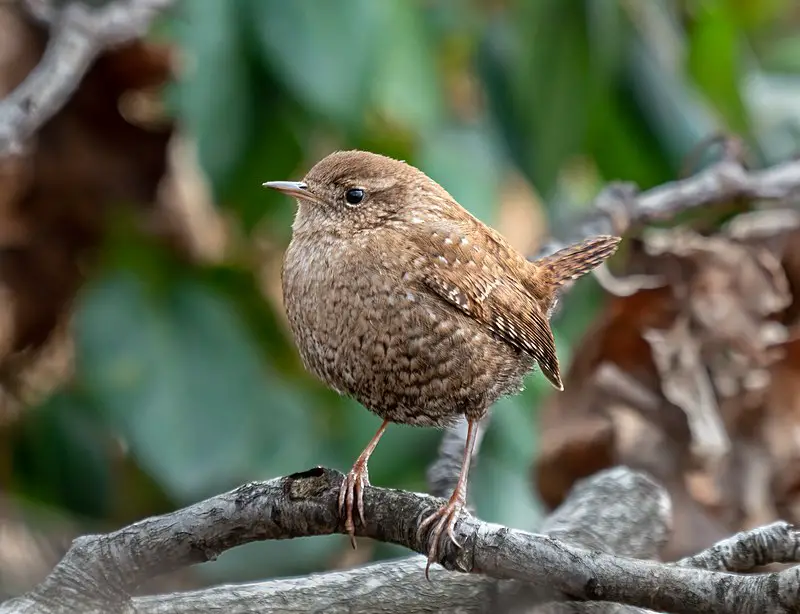
The Winter Wren is a tiny bird belonging to the New World wren family. It can be found in North America, from British Columbia all the way to the Atlantic Ocean.
In winter, it migrates south and sometimes even reaches Central America. Its habitat consists mainly of coniferous forests where it builds its nest on or near ground level within dense vegetation for protection against predators.
This small songbird has a rich brown plumage with white eyebrows and buff underparts which helps them blend into their environment perfectly.
The Winter Wrens are renowned for their loud songs that they sing both day and night during breeding season; making them an integral part of any forest ecosystem.Scientific classification:
| Kingdom | Animalia |
| Phylum | Chordata |
| Class | Aves |
| Order | Passeriformes |
| Family | Troglodytidae |
| Genus | Troglodytes |
| Species | T. hiemalis |
Also Featured In: Wrens Species, North Carolina Mountain Birds
42. Marsh Wren
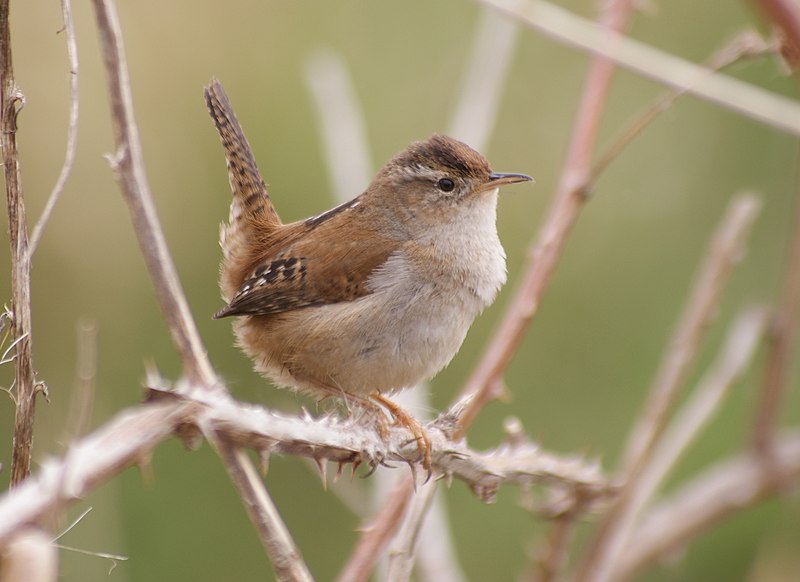
The Marsh Wren is a small bird native to North America, belonging to the wren family. It has a long bill and can be distinguished from other species of marsh birds such as the sedge wren by its size.
The Marsh Wren was first described in 1810 by Alexander Wilson under the binomial name Certhia palustris and now belongs to genus Cistothorus.
This songbird prefers wetland habitats like marshes, swamps or wetlands with dense vegetation for sheltering and nesting activities.
They build nests on grasses near water bodies which are made out of twigs attached at one end forming an enclosed cup-like structure lined with feathers or fur making it look like a woven basket.Scientific classification:
| Kingdom | Animalia |
| Phylum | Chordata |
| Class | Aves |
| Order | Passeriformes |
| Family | Troglodytidae |
| Genus | Cistothorus |
| Species | C. palustris |
Also Featured In: Most Common Songs Birds that Live around You, Wetlands Birds You Should Know
43. Sedge Wren
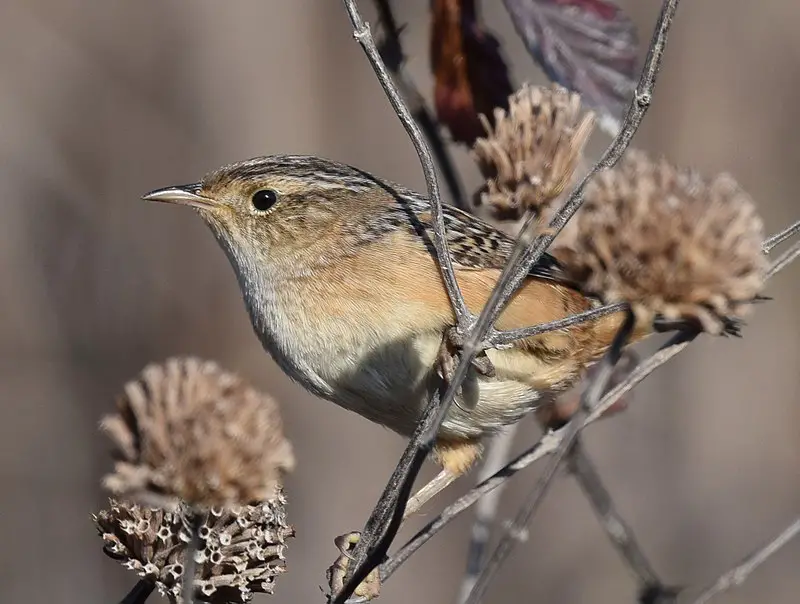
The Sedge Wren is a small, secretive bird found in North America. It prefers wet grasslands and meadows where it lives among the tall grasses and sedges, feeding on insects.
Formerly considered conspecific with the non-migratory Grass Wren of Central and South America, this species has been reclassified as its own unique species due to DNA differences between them.
However, they still share similar traits such as their brownish coloration with streaks along their back.
The Sedge Wren nests in dense vegetation which provides safety from predators while also providing plenty of food for the insectivorous birds during breeding season.
Their song consists mostly of short phrases repeated several times throughout each day making them easy to identify by sound alone.Scientific classification:
| Kingdom | Animalia |
| Phylum | Chordata |
| Class | Aves |
| Order | Passeriformes |
| Family | Troglodytidae |
| Genus | Cistothorus |
| Species | C. stellaris |
Also Featured In: Birds that Live in the Grasslands,
44. Rock Wren
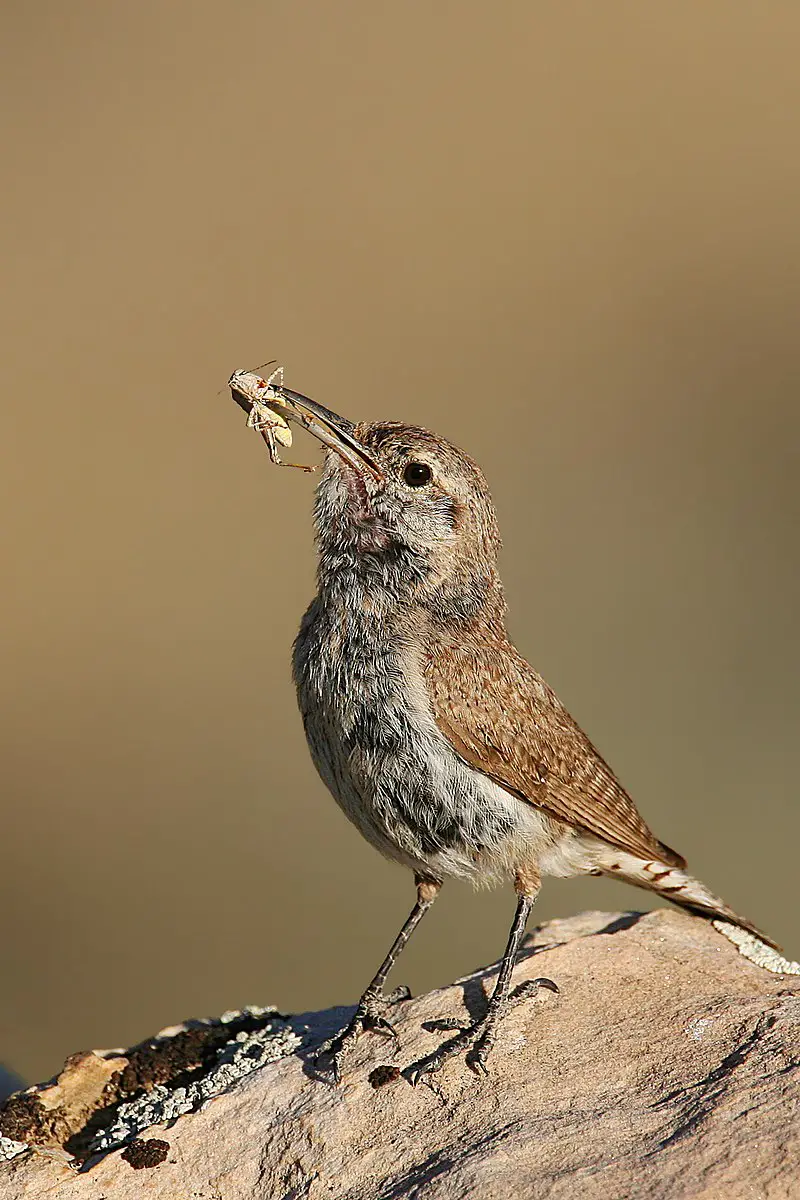
The Rock Wren is a small bird of the wren family, native to western North America, Mexico and Central America.
It features distinct grey-brown upperparts speckled with black and white spots, as well as pale grey underparts featuring a light brown rump.
This species also has an eye line that’s lightly gray in color. Additionally, it sports a long slender bill curved slightly downwards at the tip.
The wings are short but broad and rounded off with buffy or whitish colored feathers along their edges.
Its habitat includes rocky areas such as cliffsides or boulders for nesting purposes where these birds can be seen singing loud melodic songs throughout the day.Scientific classification:
| Kingdom | Animalia |
| Phylum | Chordata |
| Class | Aves |
| Order | Passeriformes |
| Family | Troglodytidae |
| Genus | Salpinctes Cabanis, 1847 |
| Species | S. obsoletus |
Also Featured In: Birds that Live in the Grand Canyon National Park, Small Kentucky Birds
45. Golden-Crowned Kinglet
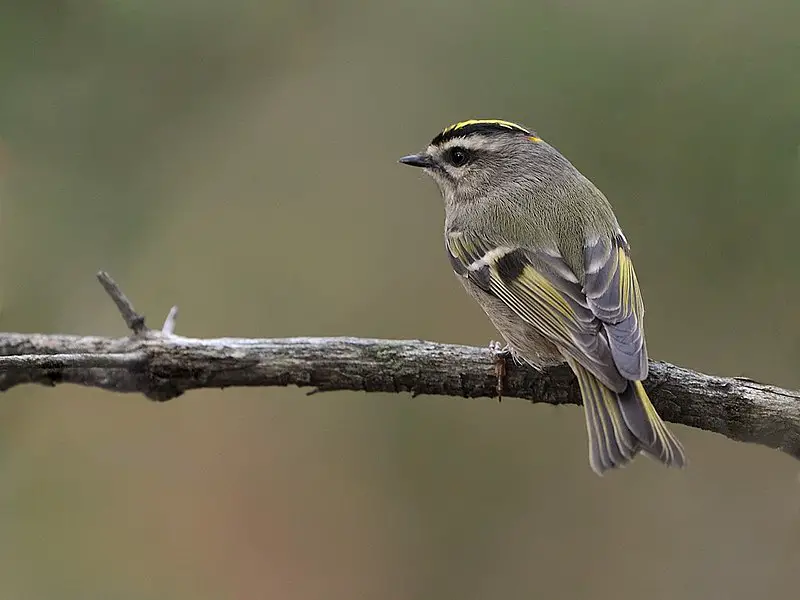
The Golden-crowned Kinglet is a small songbird native to North America. It has an olive-gray top and white underparts, with thin bills and short tails.
The most distinguishing feature of this bird is its yellow crown, surrounded by a black patch that extends through the eyes.
Males have an additional orange patch in the middle of their yellow crowns. They are active birds, often seen flitting from branch to branch as they search for insects or other food sources in trees or shrubs.
During winter months when there’s less insect prey available, Golden-crowned Kinglets will join mixed species flocks searching for berries on bushes and trees throughout forests across North America.Scientific classification:
| Kingdom | Animalia |
| Phylum | Chordata |
| Class | Aves |
| Order | Passeriformes |
| Family | Regulidae |
| Genus | Regulus |
| Species | R. satrapa |
Also Featured In: Birds that Live in Vancouver, Birds in Pacific Northwest
46. Common Yellowthroat

The Common Yellowthroat is a small, New World Warbler found throughout North America. It has distinctive yellow and black plumage that earned it the nickname “Yellow Bandit” in the Midwest United States.
This species is highly adaptable and can be found inhabiting wetlands, grasslands, shrub-land habitats, as well as suburban areas.
The genus of this bird’s scientific name translates to mean ‘ground’ and ‘small bird’, which are fitting characteristics for such an elusive yet common little creature.
Its diet consists predominantly of insects but may also include other invertebrates like spiders or worms.
Overall the Common Yellowthroat makes an excellent addition to any backyard with its cheerful song.Scientific classification:
| Kingdom | Animalia |
| Phylum | Chordata |
| Class | Aves |
| Order | Passeriformes |
| Family | Parulidae |
| Genus | Geothlypis |
| Species | G. trichas |
Also Featured In: Nebraska Birds, Birds Commonly Found in New York
47. Cerulean Warbler
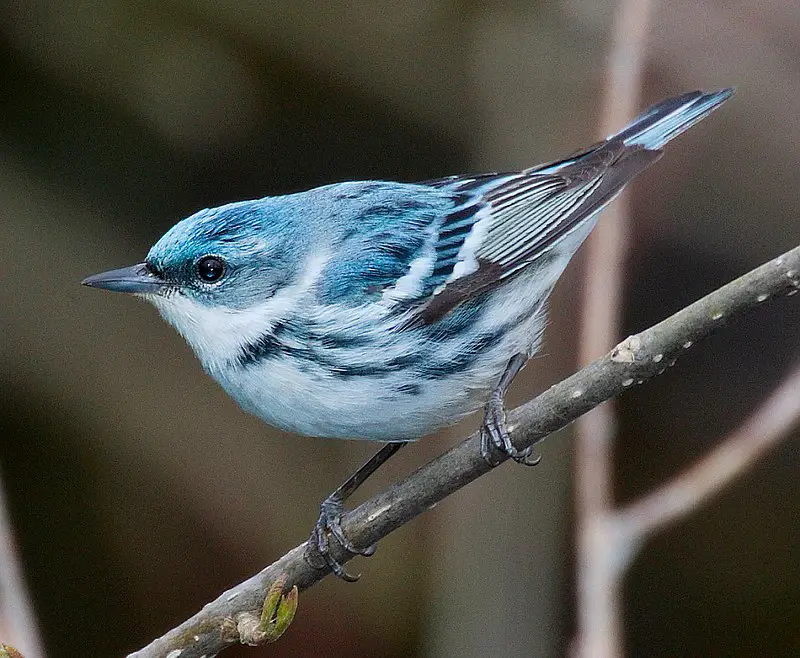
The Cerulean Warbler is a small songbird in the Parulidae family. It migrates long distances, breeding in eastern North American hardwood forests and spending its non-breeding season on the east slope of the Andes in South America.
This bird displays strong sexual dichromatism with adult males having vivid cerulean blue and white upperparts with black streaks running down their neck to chest area.
Females have an olive green color above with yellowish tones beneath them, along with some dark streaks as well.
These birds feed mainly on insects but also consume fruits during migration or when rearing young ones.
They make nests near tree trunks and lay three to five eggs per clutch which hatch after about 10 days of incubation by both parents.
The Cerulean Warbler is classified as Near Threatened due to human disturbances such as habitat loss caused by deforestation amongst other factors like climate change that threaten this species’ survival.Scientific classification:
| Kingdom | Animalia |
| Phylum | Chordata |
| Class | Aves |
| Order | Passeriformes |
| Family | Parulidae |
| Genus | Setophaga |
| Species | S. cerulea |
Also Featured In: Louisiana Birds, Large Birds of Michigan
48. Northern Parula
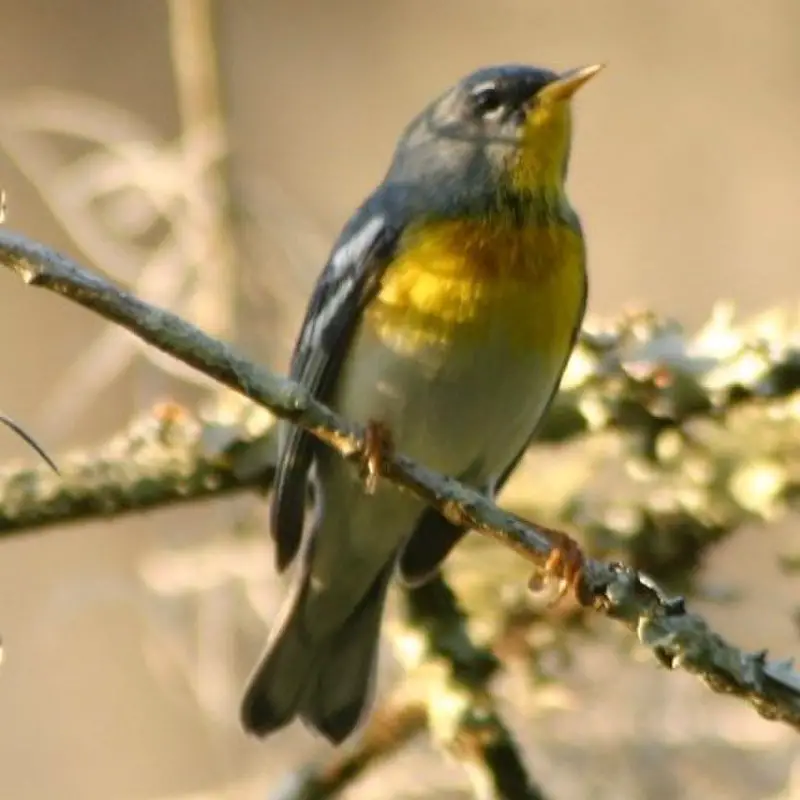
The Northern Parula is a small, migratory warbler native to North America. It measures between 4.3 and 4.9 inches in length and has a wingspan of 6.3-7.1 inches wide.
Its plumage consists mainly of yellowish green upper parts with an orange patch on its chest as well as blue crowns for males during the breeding season.
Females have duller colors than their male counterparts overall but are still quite striking from afar.
This species breeds primarily in eastern Canada down through Florida, though some northern populations may migrate southward come wintertime while others stick around year round depending on the weather conditions they face each year – truly amazing adaptability set them apart from other birds in this region.Scientific classification:
| Kingdom | Animalia |
| Phylum | Chordata |
| Class | Aves |
| Order | Passeriformes |
| Family | Parulidae |
| Genus | Setophaga |
| Species | S. americana |
Also Featured In: Maine Birds, Adirondack Mountain Birds
49. Horned Lark
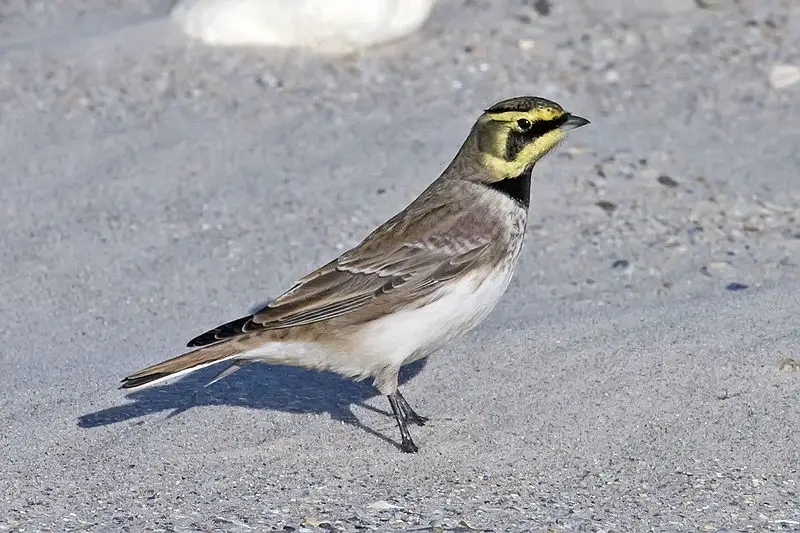
The Horned Lark, known as the Shore Lark in Europe and North America, is a species of lark belonging to the family Alaudidae.
It can be found across the northern hemisphere and has been classified under its Latin name Eremophila alpestris which means “of high mountains”, referring to its prevalence in mountainous areas like the Alps.
This bird is distinguished by two black tufts or ‘horns’ on either side of its head. Its size varies from 11-13 cm long with brown upperparts and pale whitish underparts sporting darker streaks throughout them both.
With an adaptation for ground nesting, it builds nests out of grasses lined with feathers near open fields where food sources are abundant such as insects, grains and seeds giving this species great potential for survival even when conditions may become harsh during winter months.Scientific classification:
| Kingdom | Animalia |
| Phylum | Chordata |
| Class | Aves |
| Order | Passeriformes |
| Family | Alaudidae |
| Genus | Eremophila |
| Species | E. alpestris |
Also Featured In: birds of Vermont, Ukrainian Birds You Should Know
50. Kirtland’s Warbler
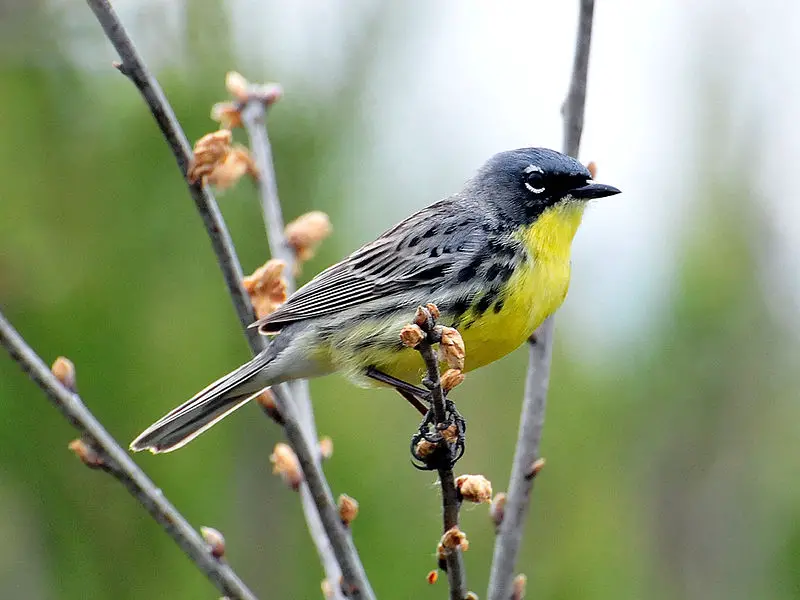
Kirtland’s warbler is a small songbird belonging to the New World warbler family and named after Jared Potter Kirtland. It was nearly extinct 50 years ago, but thanks to conservation efforts, its population has recovered.
This bird requires large areas of habitat with young jack pine stands for nesting, making it vulnerable when this type of habitat becomes scarce or disturbed.
The male birds have distinctive black streaks on their yellow chest and wings during breeding season from April through June in Michigan and Wisconsin.
Outside these months they migrate across Mexico, Caribbean islands and Florida before returning north again in springtime.Scientific classification:
| Kingdom | Animalia |
| Phylum | Chordata |
| Class | Aves |
| Order | Passeriformes |
| Family | Parulidae |
| Genus | Setophaga |
| Species | S. kirtlandii |
Also Featured In: birds of Michigan, Yellow Birds You’ll Find in Minnesota
51. Black-Capped Vireo
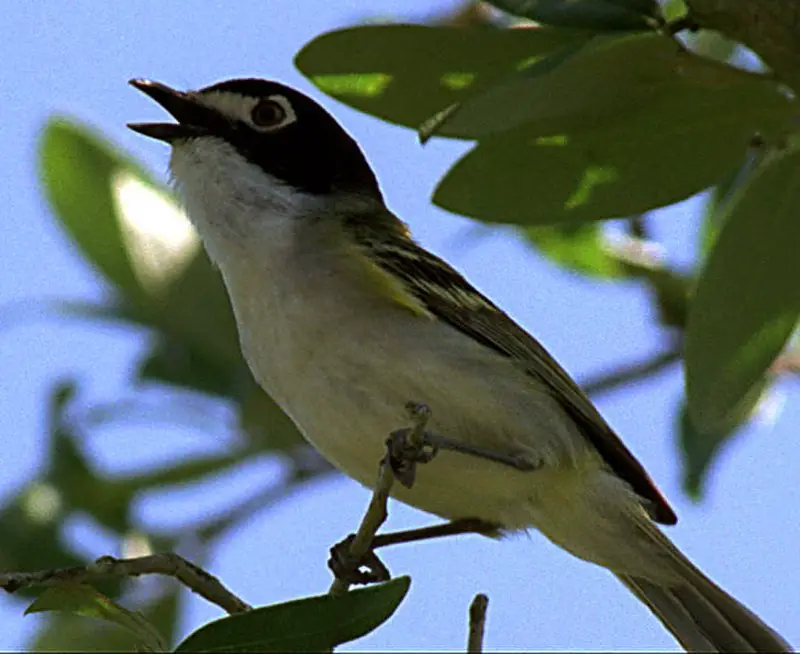
The black-capped vireo is a small songbird that can be found in the United States and Mexico. Sadly, it was listed as an endangered species in the US in 1987.
However, successful conservation efforts on the US Army’s Fort Hood and Fort Sill resulted in its delisting in 2018. Despite this, black-capped vireos are still listed as vulnerable by the IUCN.
These birds typically measure around 12 cm (4.5 inches).Scientific classification:
| Kingdom | Animalia |
| Phylum | Chordata |
| Class | Aves |
| Order | Passeriformes |
| Family | Vireonidae |
| Genus | Vireo |
| Species | V. atricapilla |